
The Internet sailors love to hate on Hunters. I’ve always thought they were beautiful sailboats. So we rented one from Harbor Yacht Club for a sail to Catalina Island to see get to the bottom of the debate.
Whomever named our test boat, Perfect Partner, must have been an Alanis Morrissett fan. Read on to see just how ironic the name turned out to be.
What’s Hot
- Great upwind sailing performance
- Very thoughtful design for inshore cruising
- Spacious and comfortable
- Smooooth 90’s looks
What’s Not
- Some woodwork and hardware of less than timeless quality
- Some design choices questionable for rough waters
- Noisy stern at anchor
- Awful support from charter company
Overview of the Hunter 36
If I had to sum up the Hunter 36 in one word, it would be easy. It’s a very comfortable boat; well suited to a weeklong coastal cruise for two couples or a family of four. Crews of five or six could certainly be accommodated for shorter jaunts without being in each other’s way. At the same time, a crew of two with little sailing experience would have no trouble handling her around the marina or through a stiff breeze. Single handing is also not out of the question here. With the purpose of coastal cruising in mind (vs racing, or offshore) the boat is thoughtfully laid out to maximize usable space, storage, and access in a hull that carries its wide beam all the way to the stern with an innovative sail design that still delivers strong sailing performance in most conditions or alongside quiet, efficient motoring.
Without list prices or monroney stickers, boat brand positioning is a bit more elusive than cars, jewelry, or blenders. However, as far as I can tell, Hunter presents as a value (low end, low price) boat. This isn’t all bad. With “mass” production, Hunter had the opportunity to invest in thoughtful design by amortizing it over a number of hulls. It’s evident that they did indeed do this on the Hunter 36. To keep the price low, there are sacrifices in some materials and hardware. With that constraint mind, I think they did a pretty good job investing where it counts while pinching pennies in areas where it worked. I don’t think the balance is perfect, and I’ll put on my observations on this throughout the review so you can decide for yourself.
The Hunter 36 came standard from the factory very sparsely equipped, like our test boat. However, it could be optioned up with a surprising amount of equipment for a boat of this size, especiallay given its value orientation. Available options included generator air conditioning and a fresh water plumbed electric head (toilet). This approach makes the boat more accessible to day sailors while allowing it to be fit to accommodate longer range cruisers in harsher climates.
How Big is the Hunter 36?
Hunter is known for putting a lot of boat in a given length, and the 36 is no exception. The boat carries a lot of beam all the way to the stern (the back half is wide). Our crew of three: myself, my wife Rachel, and our son George (13 years-old) crewed this boat for four days and four nights. On this trip, we had far more space to sleep, lounge, and keep our crap than we needed. We found plenty of storage, seating, and tankage. Both staterooms offered enough room to dress with the doors closed. The bathroom had a (sort of) dedicated shower with room to swing your arms. It made having only a single head much more livable.
Despite all this space, the boat is very manageable. From the helm, it was easy to see where the bow and the sides were. It was also relatively easy to reach the sailing controls (lines) from the helm, and to reach the helm from a number of seating positions. It was light enough to be easily pulled along the dock by its lines.
At the Helm of the Hunter 36
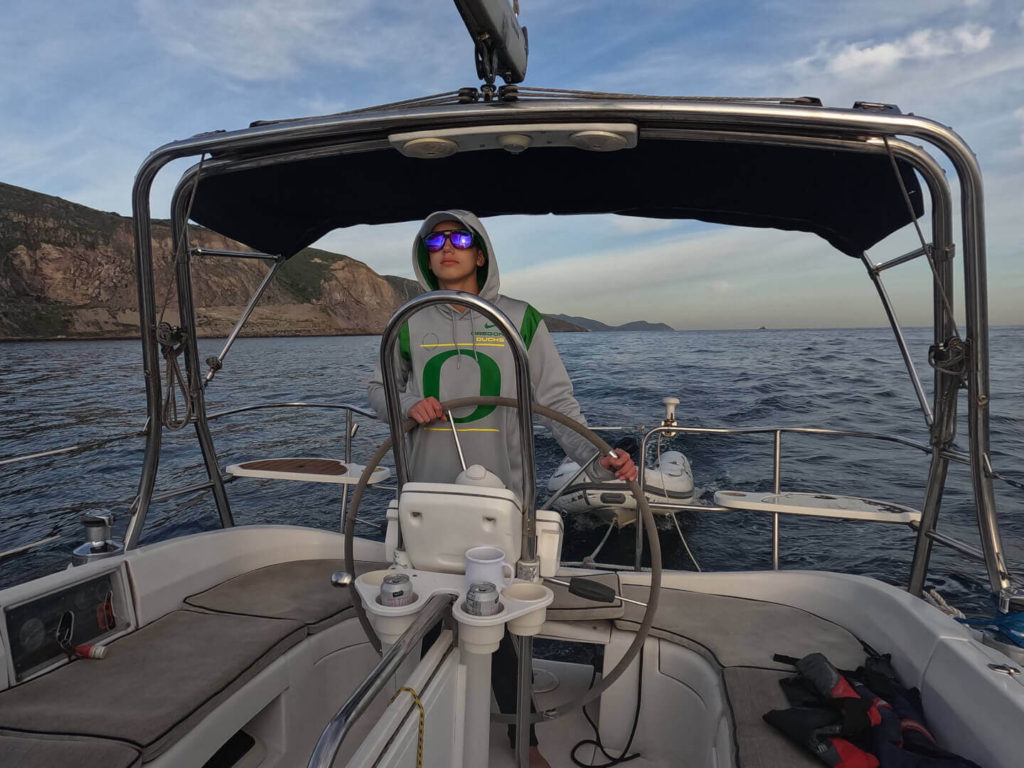
The cockpit is narrow enough that you can hold the wheel while working a jib sheet from the winches located at either side. With the mainsheet traveler located on the bimini over the wheel, you can adjust the mainsheet from here too. While I don’t really do much with the traveler because I’m a very amateur sailor, it does get those lines out of the way where they’d otherwise contribute to a rat’s nest on the coachroof.
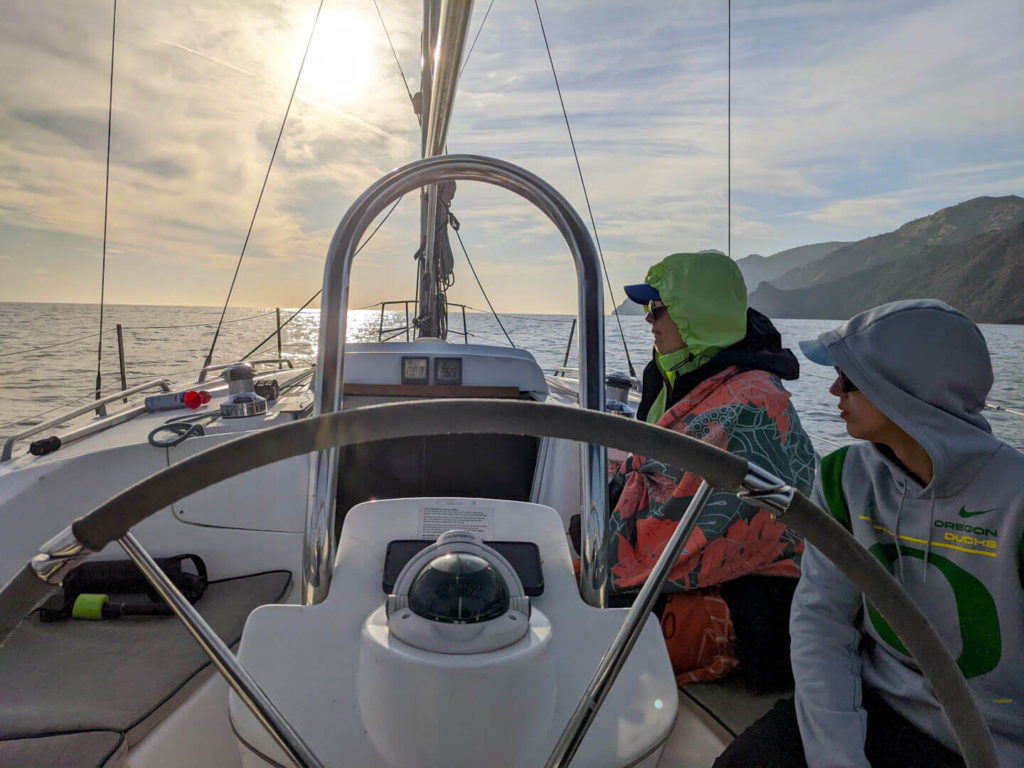
Visibility from the helm was super awesome. I could see more while sitting behind the wheel than I could standing on some boats. The speedometer and depth sounder where mounted above the companionway. This kept them from cluttering the helm, but still easily read from the wheel. I’m six feet tall, but I usually prefer to stand at a sailboat helm to get adequate visibility. This was not the cast on the Hunter 36. From a seated position, I could see the compass, gauges, and even quite a bit of water off the bow. Of course, the lack of a dodger or binnacle mounted electronics certainly contributed to this clear line of sight.
The mainsheet runs down along the boom and mast to its winch on the coachroof as is typical on cruisers. So, without autopilot, you won’t be able to work the wince with your hands on the wheel. This makes single handing more challenging. However, having the lines spread out but mostly within reach strikes a good balance of keeping the clutter at bay while making for light handed sailing.
As a relatively base boat, Perfect Partner was not equipped with autopilot. However, the hub on the Lewmar wheel could be tightened to hold the rudder position.
This boat uses a rack and pinion steering system. I didn’t notice any difference in feel or effort compared to the cable steering attached to most sailboat wheels. A mechanical steering rack is more expensive and theoretically superior to cable steering. So, its surprising that this was selected by the (value oriented) Hunter engineers.
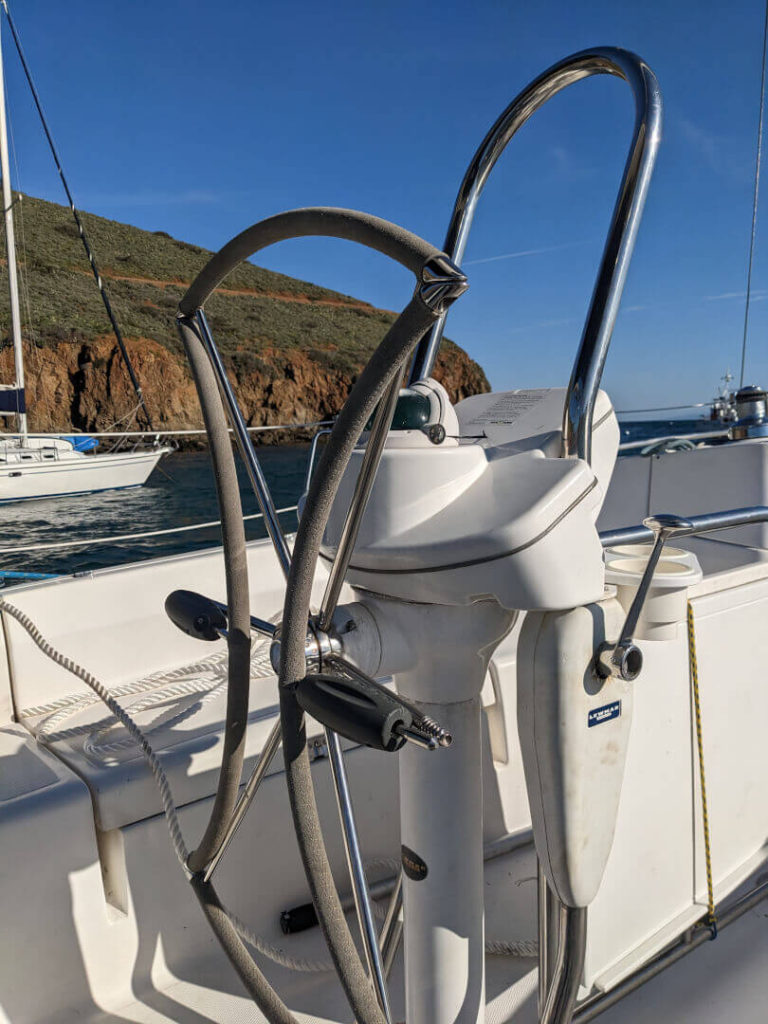
The Lewmar wheel can be easily folded inward when moored to free up room to move in the cockpit. The system is simple with two plastic covers that you unscrew to fold. However, the system relies on a very small bungee to stay folded…and one of our bungees was broken, leaving one side swinging about.
Electronics
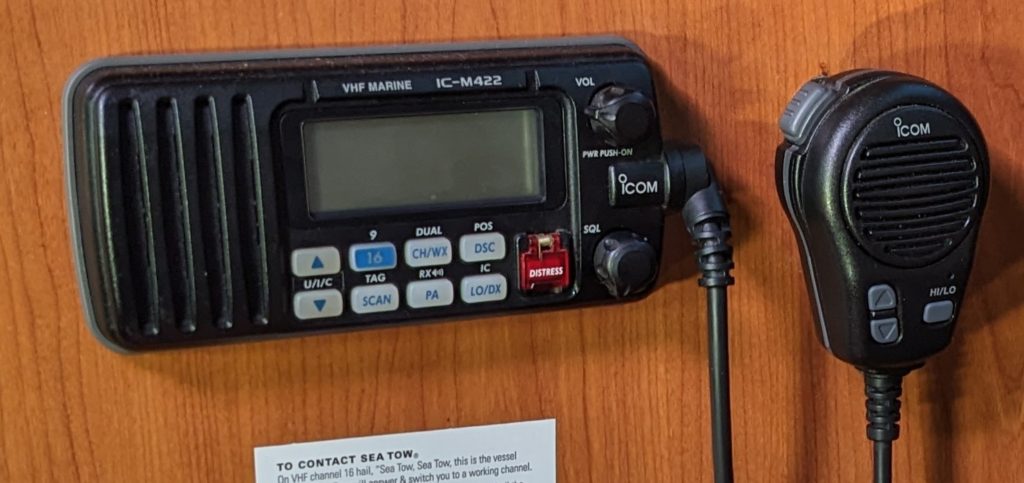
Our Hunter 36 was light on electronics. It was equipped with a newer iCom IC-M422 VHF mounted at the nav station. I really liked this VHF because 1) the channels were labeled on the display; I always forget which channels are for what, so this gives me extra reassurance that I’m on the right channel (9 is emergency, 16 is hailing, etc) and 2) when our batteries went dead, the VHF held on longer than anything else on the boat. When you have an emergency, that VHF is your lifeline, and it really gave us more than I ever expected on this trip.

Our boat was also equipped with a pretty basic Furuno GP-32 GPS at the nav table. By basic, I mean that this is an old fashioned GPS, not a chart plotter. You go through a painful task of entering a series of waypoints the same way you would enter your initials for a high score a PacMan arcade console. Then it tells you whether your are to the left or right of your plotted course. No maps. It is (was?) a very high end unit in that it has a WAAS receiver for improved accuracy. We relied on the Navionics app on my cell phone and left the GP-32 in the off position.
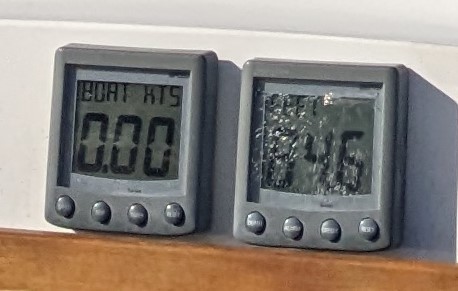
Instrumentation in the cockpit was limited to two Raymarine ST-60 displays mounted above the companionway. One showed depth and one showed water speed. As per usual, the water speed transducer was broken. If you have any tips on getting these buggers working, hit us up in the comments. While the ST-60 package was available with a wind system, our boat omitted that option in favor of a simple mast mounted windex.
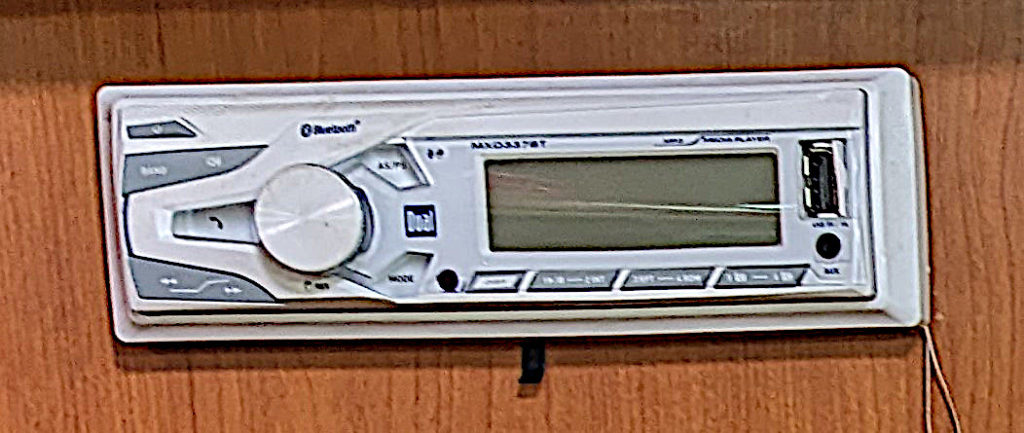
Of course, no great boat is complete without a CD player. Perfect Partner was equipped with a Dual (Dual is a cheap flea market brand that has experienced increased distribution in recent years thanks to the advent of e-commerce) Bluetooth media player. Like many modern head units, especially marine head units, the CD player is no longer included. Unfortunately, enough buttons were broken on this particular unit that we could not change the channel from NPR or get it to pair with our phone. This means I can’t tell you how awesome those 15 year-old bimini mounted marine speakers rock the anchorage.
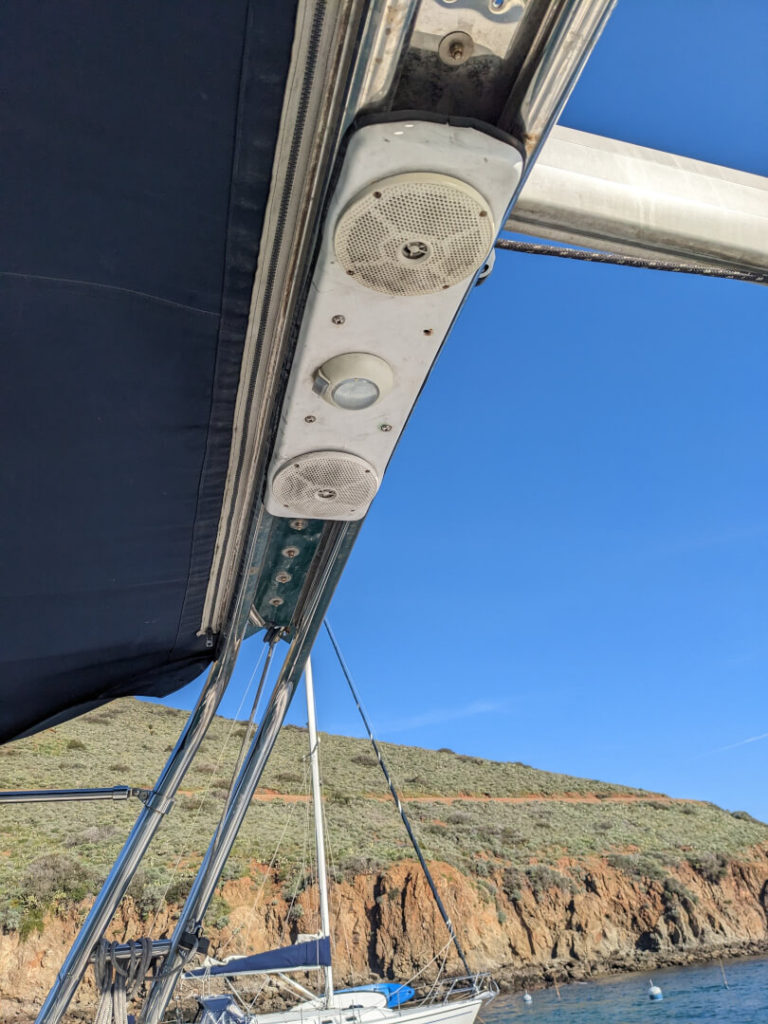
Under Way in the Hunter 36
Sailing the Hunter 36
We purposely traveled early on our trip for light winds. I was more interested in light wind performance because the rivers, lakes and sounds of the Pacific Northwest, where we sail the most, don’t deliver consistent trade winds. Not to mention, Rachel prefers the calm waters that come with light wind. We were very impressed at how easy it was to build momentum and get steerage with almost no wind, especially considering the fat pig of a hull we were dragging through the water.
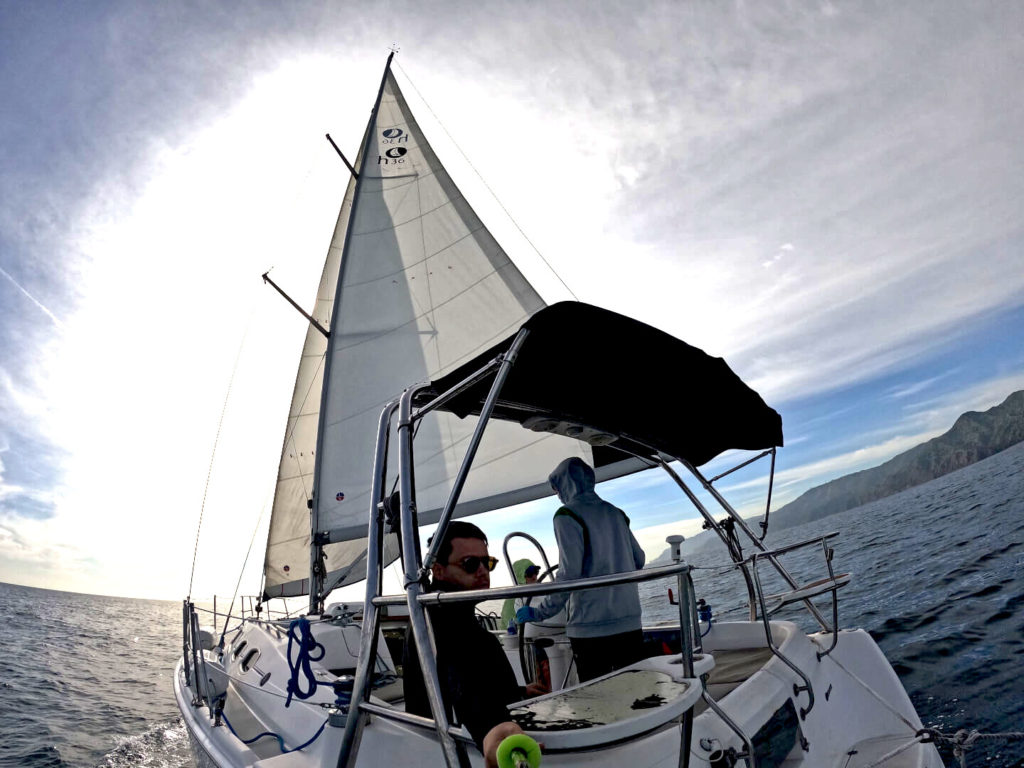
So common on newer cruising yachts, our boat was equipped with a roller furling jib and in-mast furling main. As long as everything is working properly, this keeps us in the cockpit when raising and lowering the sails. It also allows us to more easily adjust our sail area, when compared to taking in a reef or changing our head sail.
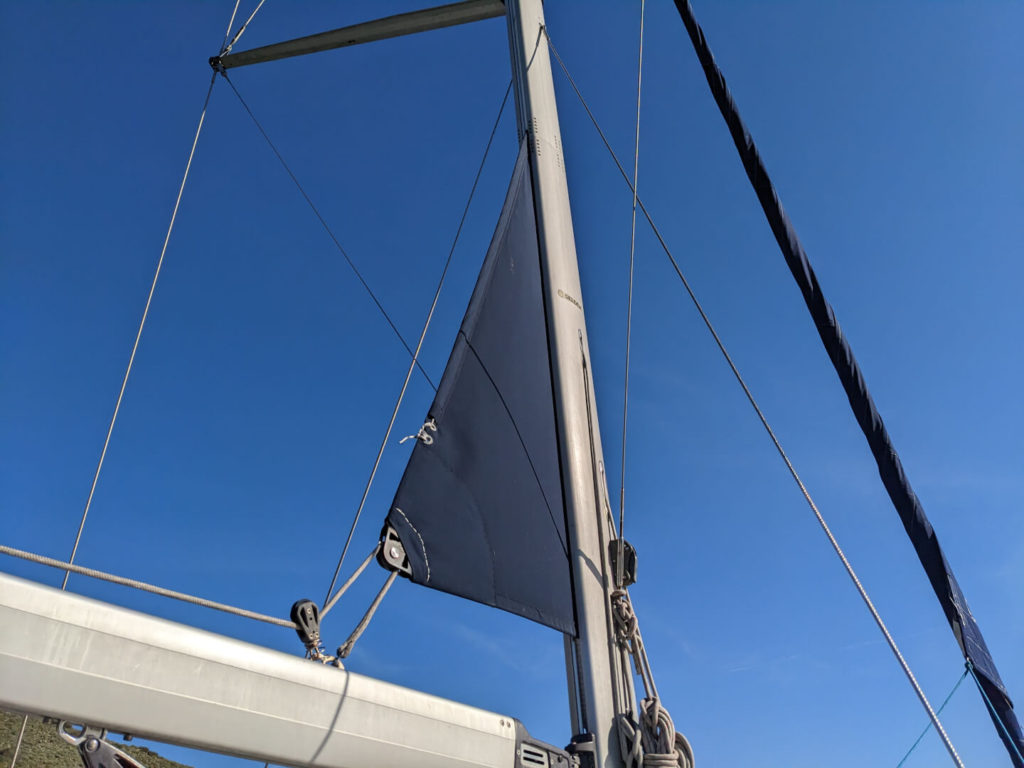
Rather than a mile of line that wraps around the mast to turn the in-mast furler, the Hunter 36 has a relatively short loops of line attached that runs through a second winch on the mast. The obvious advantage is less line to manage on the deck. You also have the option of heading up to the mast and attaching the winch handle to the winch directly. You might first say, wait, don’t you need to be careful not to over stress the equipment when winding. Well, yeah, that’s true. But the downside to the furling loop is that it needs a lot of tension which can be hard to keep on both ends when winching from the coachroof. So you need that option to make this rig work. I don’t know why the furler is designed this way, but it kinda sucks.

Another nice touch for resort sailors like us is a fold down table that doubles as foot wedge while the boat is heeling.
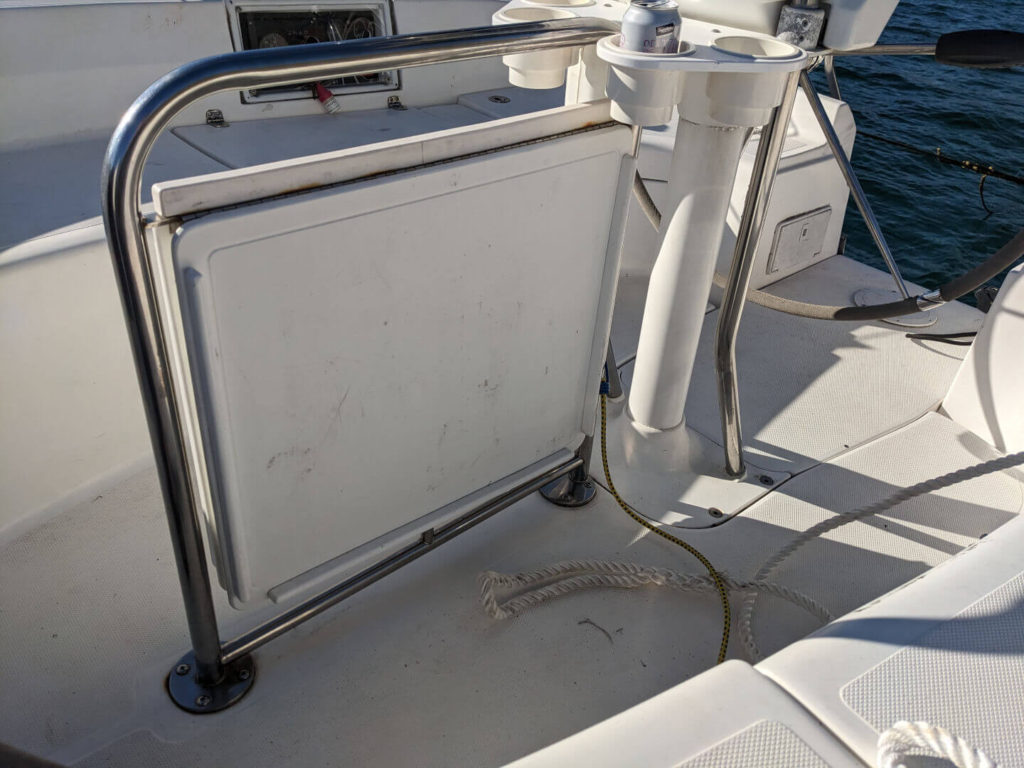
Line Management
As cruisers, we want sailing controls that are easy to access without causing clutter or obstructing the seating area…without sacrificing sailing performance. Hunter really hit the sweet spot on this boat, IMHO.
On the coachroof on either side of the companionway, we have a set of three clutches ahead of a winch, which is in turn ahead of a molded in pocket for holding lines and winch handles. There’s also plenty of room between the winch and handrails setting crap while under way: boat hook, horn, handheld VHF, and uhh flip flops.
The port (left) winch hosted the boom vang and main furling lines. The starboard (right) winch hosted the mainsheet and outhaul. You know, when I look at the photos from our trip, I can see there is a topping lift, but if I’m being honest, and that’s my job here at Busy Boater, I didn’t notice it or release it on our trip…she seemed to sail just fine anyway.
Our boat was not equipped with a spinnaker, but there was an extra clutch and a few empty blocks that I guess were available for adding one.
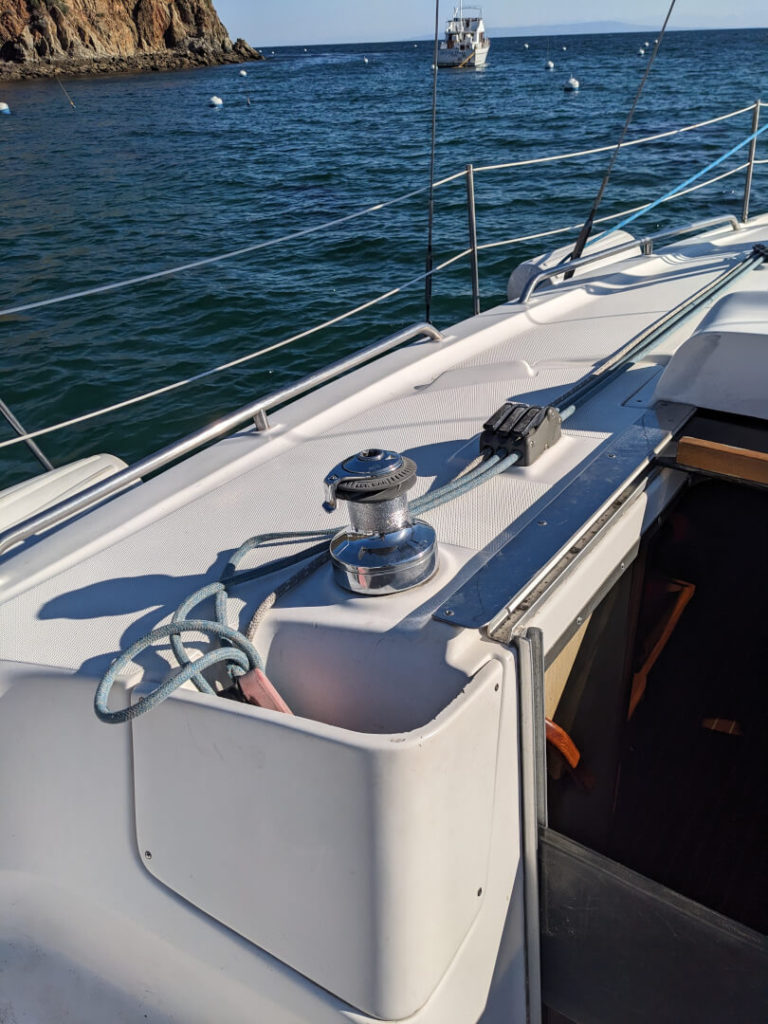
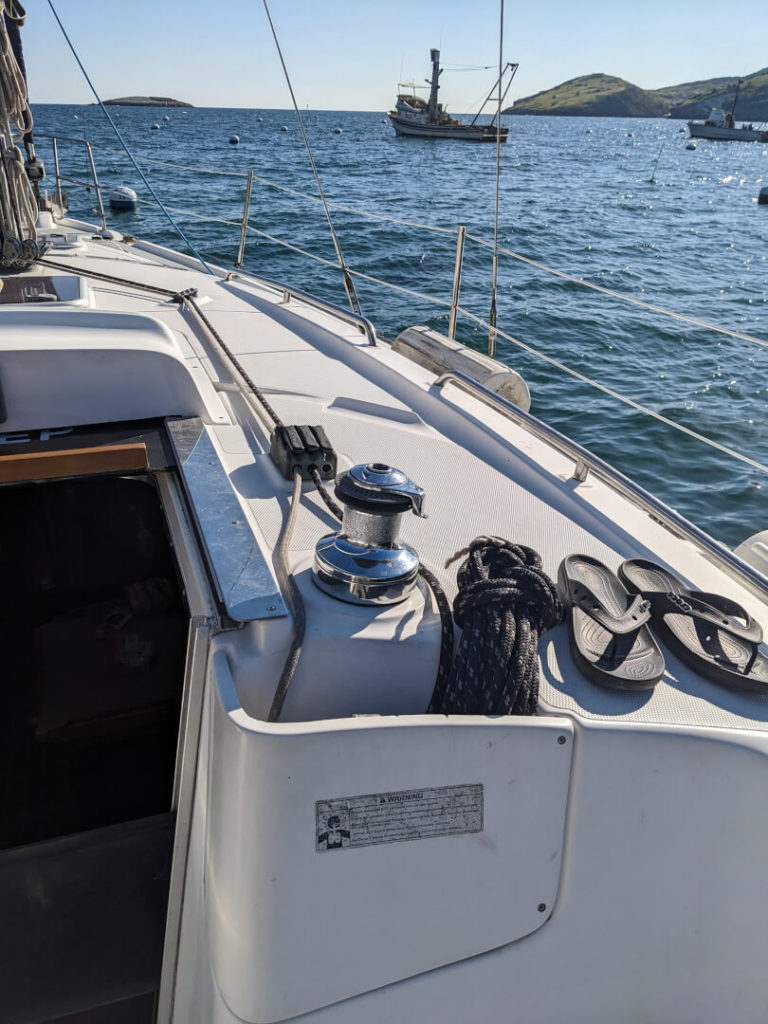
In line with the helm, we have the mainsheet traveler and the jib sheet winches.

Almost all branded hardware on this boat was Lewmar, but the jib travelers were Harken. I can’t say if one is better than the other, but thought I’d mention in case you care.

B&R Rig
The Hunter 36 is equipped with a rig that uses swept spreaders that eliminate the backstay. Eliminating the backstay entirely allows for a larger mainsail as there’s no concern of the sail or boom hitting the stays. This is a more elegant solution to getting the backstay off the stern than we saw on the Jeanneau 43 DS. The Hunter 36 takes advantage of this by integrating a stout stainless steel arch at the stern that makes it look like a wakeboard boat. The arch serves as a mounting point for stereo speakers, lighting, and a small bimini, just like a wakeboard boat. For improved sailing efficiency, Hunter has also mounted the mainsheet traveler up here. While most cruisers have the mainsheet on the coachroof to keep it out of the cockpit, the arch allows it to be placed further aft like you’d see on a racer. I don’t know the science, but I know that on my Hobie Cat, when I mounted the mainsheet block in the wrong place on the boom, it slowed the boat WAY down. So, I truly believe that this ability to get the mainsheet mounted further out on the boom where the engineers wanted it makes this boat measurably more efficient to sail. Having the mainsheet back here also makes it easy to trim the sail from the helm. In this boat, you can reach both jib sheets and the mainsheet without letting go of the wheel. Again, it has its advantages: looks cool, mounts speakers and lights, makes boat fast, but, unlike a folding bimini, you can’t get it out of the way. While the boat was equipped with raised seats at the rear of the cockpit, I found them worthless because the canvas on the tower blocked any view you’d have of the mainsail.

I don’t really know anything amount mast bend, but apparently the B&R rig allows for favorable mast bend. That, along with the fuller mainsail and ideal mainsheet mounting, add up to strong upwind performance. We always talk about tradeoffs in sailing, and the swept spreaders limit your ability to let the mainsail out for downwind sailing. This is less of an issue if you’ve got a spinnaker, but our boat was not equipped with a spinnaker or spinnaker hardware…and I don’t know how to use one anyway.
The Internet was unkind to the B&R rig when Hunter implemented it: there are a lot of assumptions about the strength of a rig that has deleted the backstay. Sailing downwind will tend to push the mast forward. On a more conventional rig, the backstay is what holds the mast up in this scenario. This would be one area that the high production numbers supported engineering to ensure the swept spreaders combined with a keel stepped mast could handle this load. How do I know? There are hundreds of these boats that have been plying the ocean for over ten years without being dismasted.
So How did She Sail?
Now that we’ve talked about design, I’m sure you want to know, did it work in the real world?
With the wind at our beam, and a desire to get into port before the weather picked up in the afternoon, we motorsailed from Long Beach to Two Harbors on our first day. We just had the main out, no jib on a beam reach making just over 6 knots.
Later on, when we lost our engine in almost no wind, we were able to very quickly get the boat moving and would have had a great time sailing the final four nautical miles into Avalon. Unfortunately, had we done that, we wouldn’t have had any help picking up a mooring when we arrived. So we accepted a tow, which was the fastest point of sail for our entire trip.
Docking the Hunter 36
Even without the help of thrusters, fancy props, or a sail drive, we found docking the Hunter 36 to be a complete cinch. When going in reverse, it took a moment for the prop to bite. However, in both forward and reverse, we had no trouble turning the boat in either direction and did not notice any prop walk. The small engine allowed us a wide range of slow speeds when navigating mooring fields. The boat did not have a lot of momentum, so it was easy to start, stop, and change direction. The boat’s pivot point was very close to the center, making it easy to turn sharply in small spaces.
I found the size of the boat to be very manageable in close quarters. The crew had no trouble talking back and forth between the cockpit and the bow. It was relatively easy to estimate distance from docks alongside and buoys on the bow from the helm.
Personally, I prefer as little draft as possible. This reduces our overall chances of grounding, and gives us more flexibility in looking for moorings/anchroages, and reduces occasions that might require us waiting for a tide change. Depending on design, this can come at the expense of sailing performance. Generally, this is an advantage for smaller boats. So, I was surprised that the Hunter 36 carries a 6’5″ draft, about the same as the Jeanneau 43 we tested. A quick review of other fin keeled cruisers in the size range shows most do run in the mid six foot range. Catalina being an exception with only 5’9″. However, we had almost no concerns with shallow water cruising the well marked channels of long beach and the deep waters off Catalina Island.
How Does the Hunter 36 Handle Rough Seas
Hunter haters will say that Hunters are not ‘blue water’ boats: they don’t have what it takes to cross oceans. While I was in no way surprised by this, I can confirm that the Hunter 36 is not a ‘blue water’ boat…but I’m not interested in an ocean crossing. I just want to take an easy sail on a nice day with my family. Hunter, and many other production boats are great for that. We didn’t find anything inherently unsafe about the Hunter 36 design or build for our purposes
In fact, its ‘less seaworthy’ design lends itself to our purposes. The Hunger 36 has a very open cockpit that makes it easy to board a dinghy on the transom or to walk up to the mast and bow. It’s also got some generous storage lockers in the transom that would be dangerous in a big following sea. I’m sure the fin keel that makes docking a cinch and the wide beam that gave us a spacious cabin also become liabilities in heavy weather. The aforementioned B&R rig is often cited as a liability in higher winds. Hunter’s been built thousands of boats with this design and I can’t find a single story of one being dismasted.
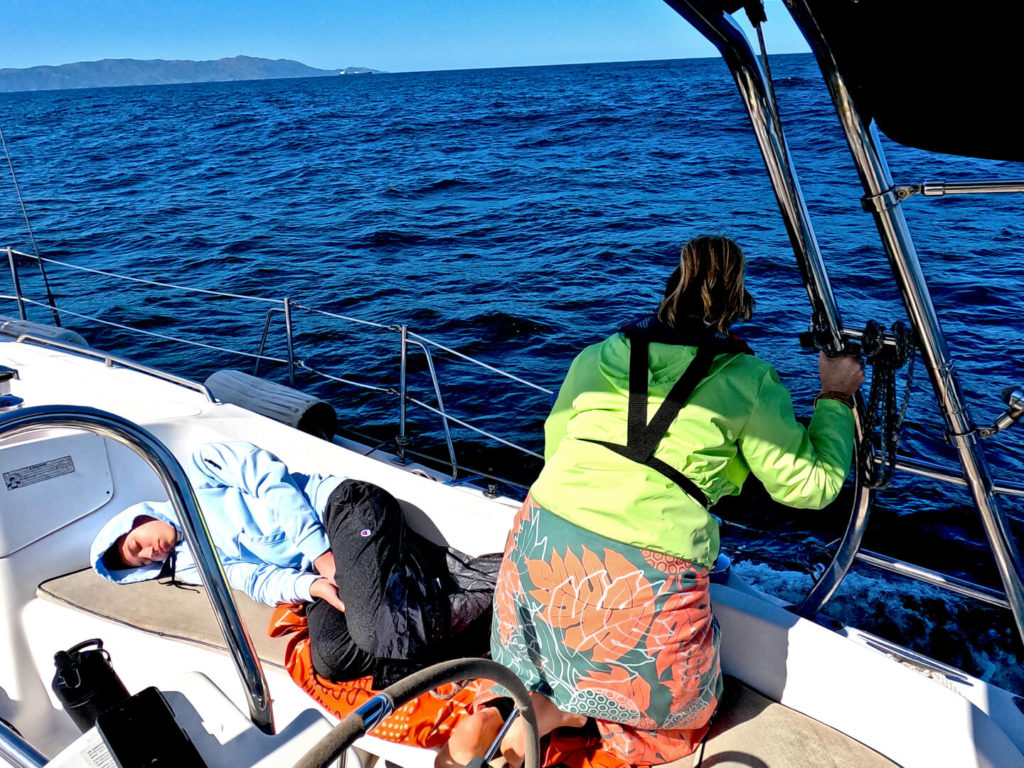
We sailed into four foot seas for several hours on our passage from Long Beach to Catalina Island. Granted, I’d characterize them as soft four footers as they were mostly swells without white caps and a long 8 second period between them. We took most of the waves alongside or on the forward quarter. We easily maintained steering throughout the trip and never at any point felt like to boat was anywhere near its limit. All three of us suffered from varying degrees of seasickness from all the rocking and rolling, but you’d be hard pressed to find a boat under 40 feet that wouldn’t have had the same impact on our weak landlubber stomachs. Perfect Partner has probably made this passage hundreds of times in various conditions during its 15 years of charter service and it remains a very solid boat.
Hunter 36 Exterior
The Hunter 36 exterior is laid out like most modern cruising monohulls. An open stern leads to a cockpit with a companionway leading down to the cabin. A narrow walkway on either side of the cockpit leads forward to the mast and bow; none of which are designed for lounging. One item of note on this boat is that the mast sits much farter forward than you might expect.
Hunter 36 Cockpit
The cockpit has a level floor throughout that allowed you to walk a full 360 from the stern to the companionway without climbing. At the companionway, there is only a small lip on the bulkhead to step over to get to the stairs.
The generous seating formed a continuous U shape across three sides. A molded seatback on the cockpit sides was adequate, but still not as comfortable as leaning against the cabin walls forward. The short, narrow seatback did, however, make it easy to step out onto the deck. Without any backs at the stern, I was more comfortable sitting to the side of the wheel to rest my back.
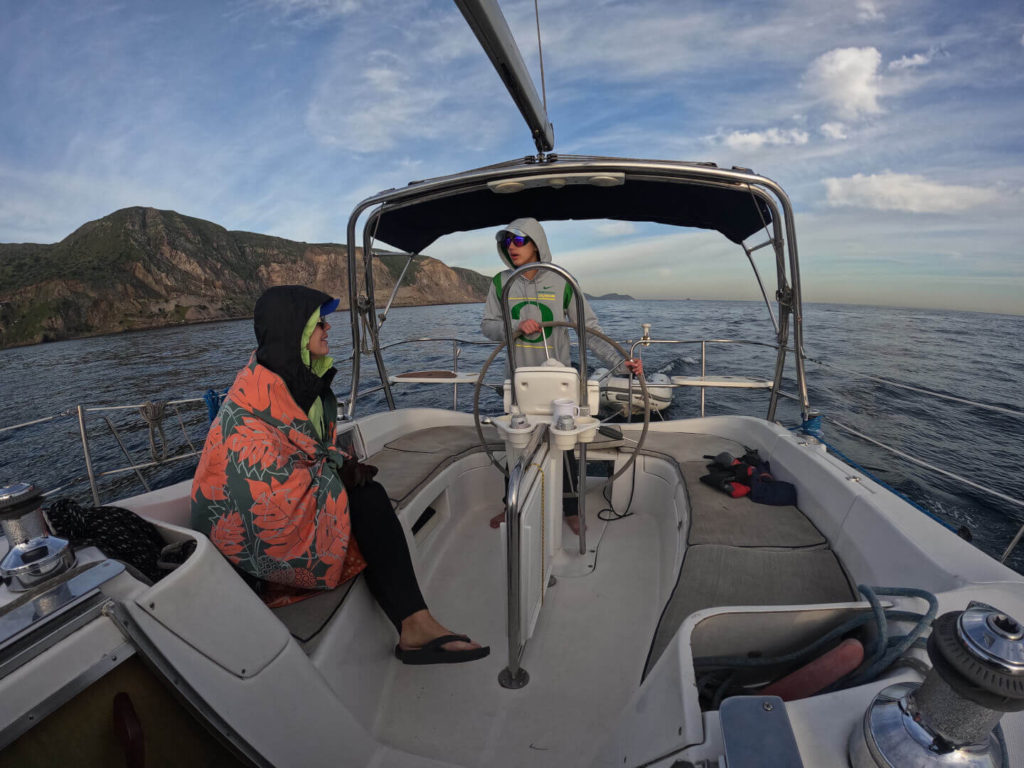
The cockpit has a set of four cupholders and folding table forward of the wheel. The folding table did not have a solid latch on our boat and was held closed with a bungee. Without the bungee set perfectly, the table sides would slap the frame as the boat crossed waves, both at anchor and underway…very annoying. Four cupholders on the other hand, was awesome, great spot for cell phones as well as bevvies.
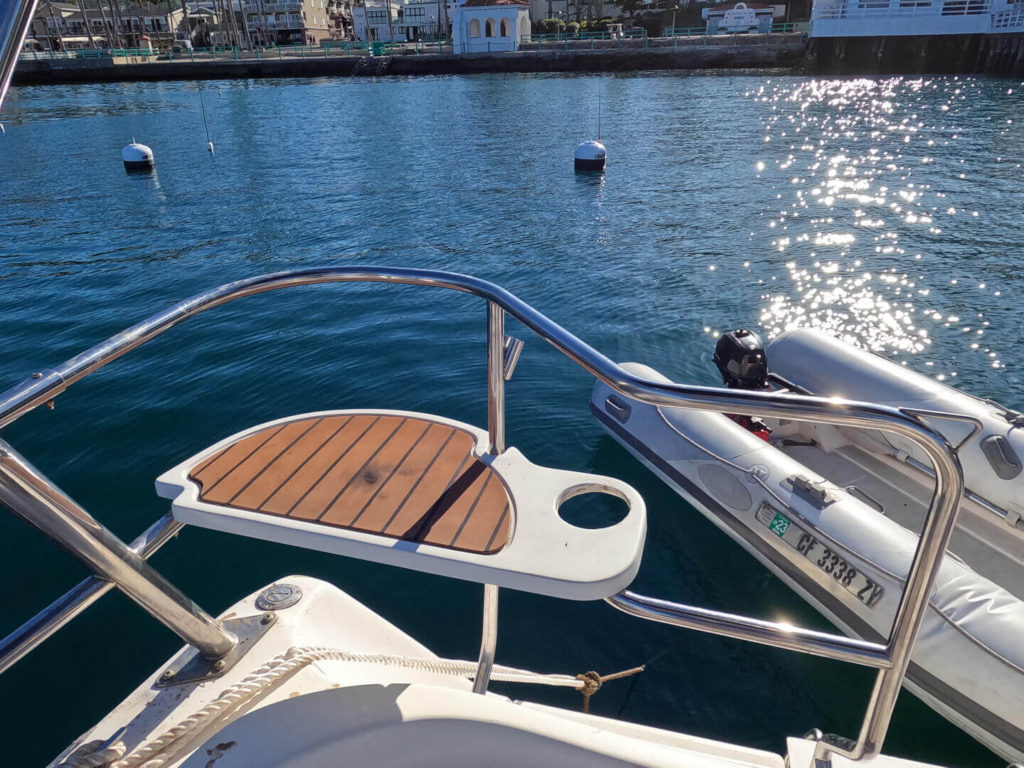
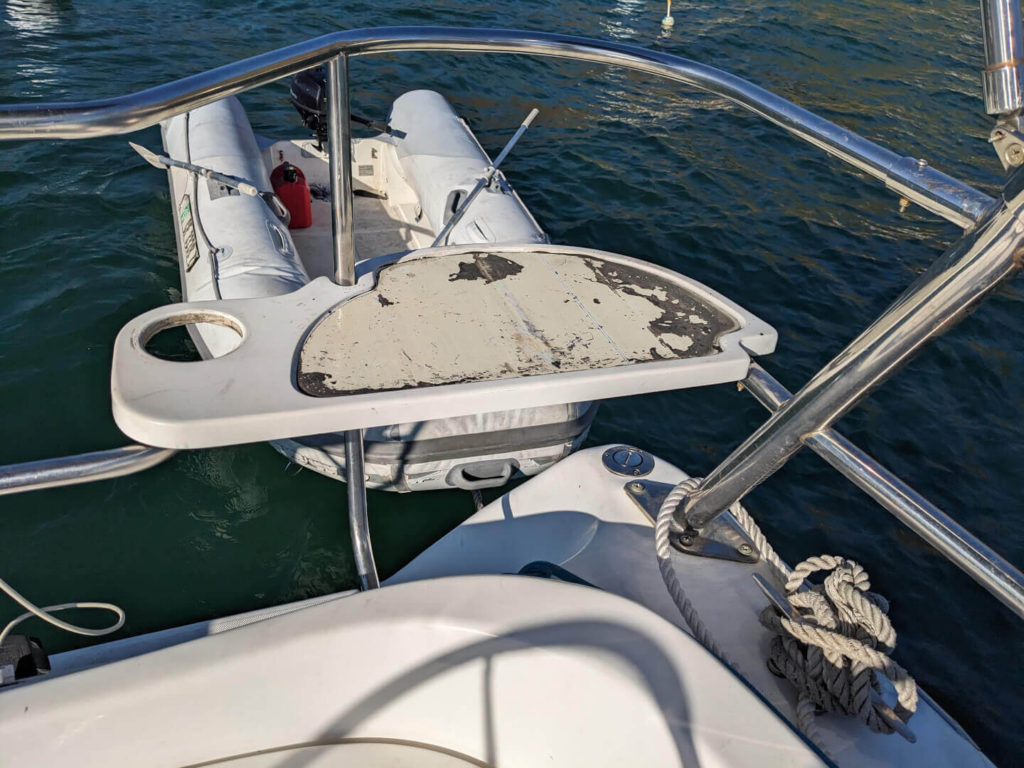
There are two holes for cupholders on the stern seats, but the cupholders seemed to have been lost at some point. Note here that hunter applied stickers at the factory to these seats for a faux teak and holly look…they did not age well and would have looked better if designed in plain white.
Cockpit storage on the Hunter 36 is limited to two underseat bins on the port (left) side. A shallow bin at the stern is great for stowing deck lines. The forward seat and back hinges open to reveal a large hatch and a very deep bin that spans the length of the cockpit and the full depth of the hull. All of the smelly dime store orange life vests were stored hear underneath the cockpit cushions. While this space is very roomy, its a bit hard to keep well organized. Additionally, the batteries are underneath one end of all of this crap and, as we learned the hard way, can be a bit cumbersome to access in an emergency. There’s no storage on the starboard (right) side of the cockpit because the stern stateroom utilizes the underside of the bench for headroom with propane tanks stored in the aft (rear) bin.

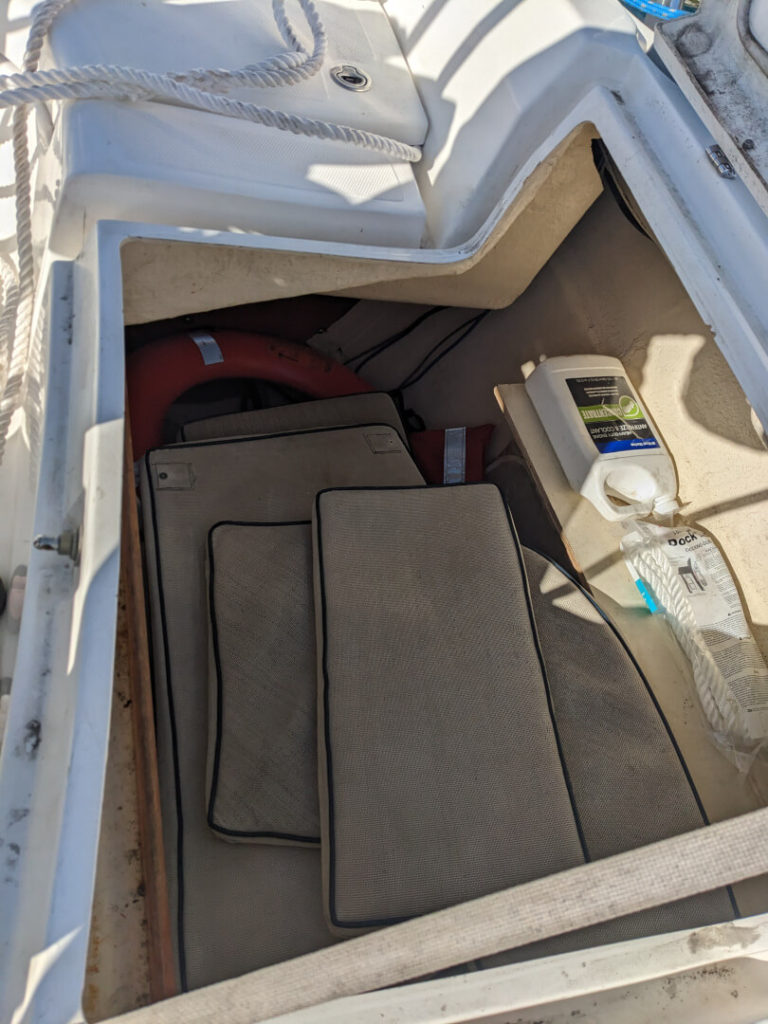
Hunter 36 Stern
The ‘sugar scoop’ transom stern has a swim step and plenty of railing to grab when approaching with a dinghy. Unfortunately, there isn’t much meat to grab onto between that first step and the cockpit. This makes dismounting from the dinghy a bit precarious. Additionally, when the transom seat is folded open (pictured above), it mostly covers the lower step, making it hard to step down towards the dinghy.
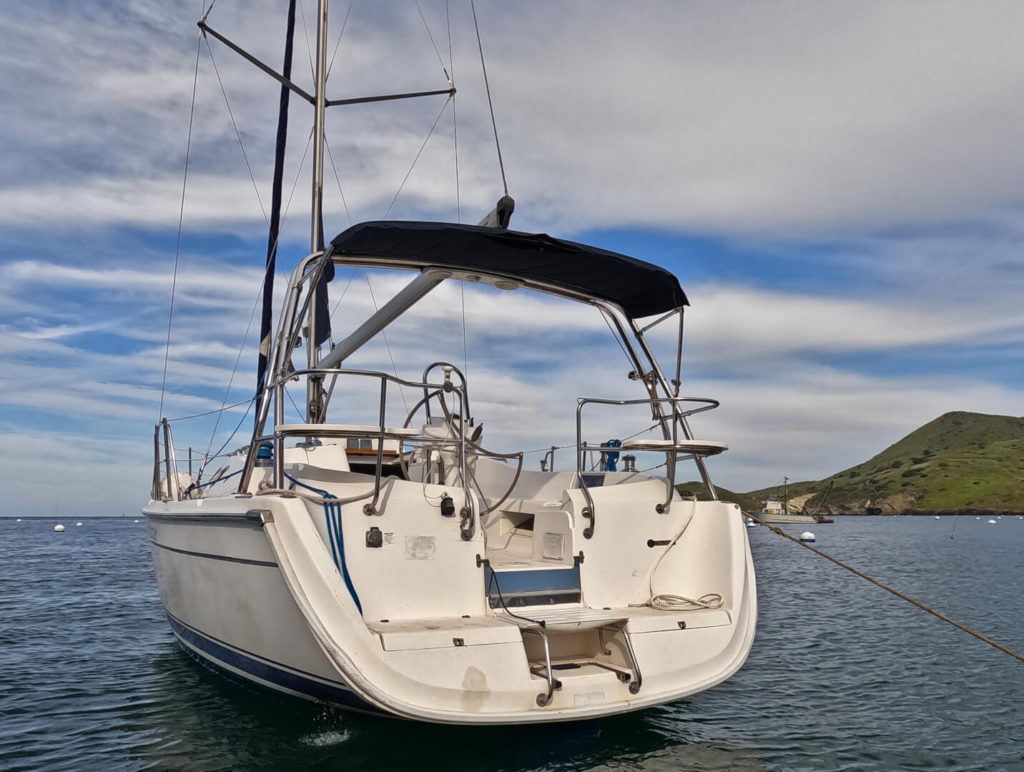
The helm seat serves to close the stern when under way, then folds down to form a step when at anchor. Its a very innovative design, but as mentioned above, the execution out on the transom is a bit awkward. While it’s a huge improvement over a fully enclosed transom, it doesn’t quite hit the mark. Adding some handholds on the sides of the steps, or even on the outer edge of the transom, would make it much easier and safer to board at this end.
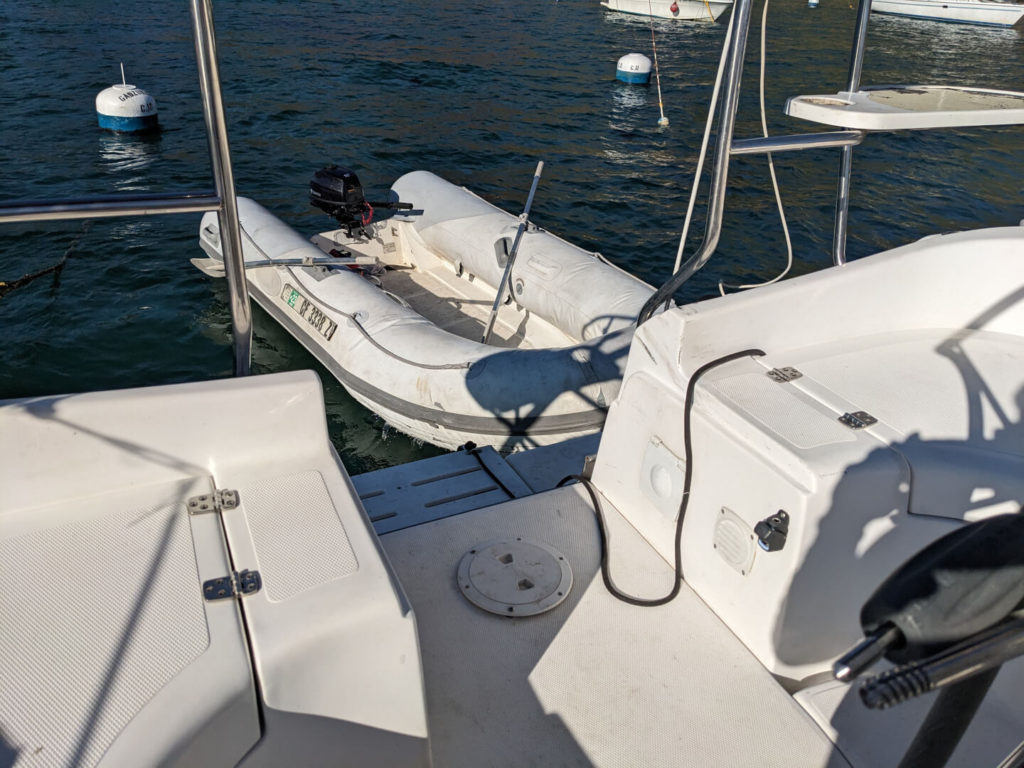

A few other items to note on the transom: a shore power receptacle is mounted on the port side. Then under the helm seat, you’ll find a hot/cold freshwater washdown hose on the starboard side and the manual bilge pump on the port side. I guess there are worse places to mount the manual bilge pump, but think about sitting back there in the big open gap with the helm seat swung away in rough seas while another crew member is swinging around at the helm just in front of you…you’d sure as shit better have a harness on.
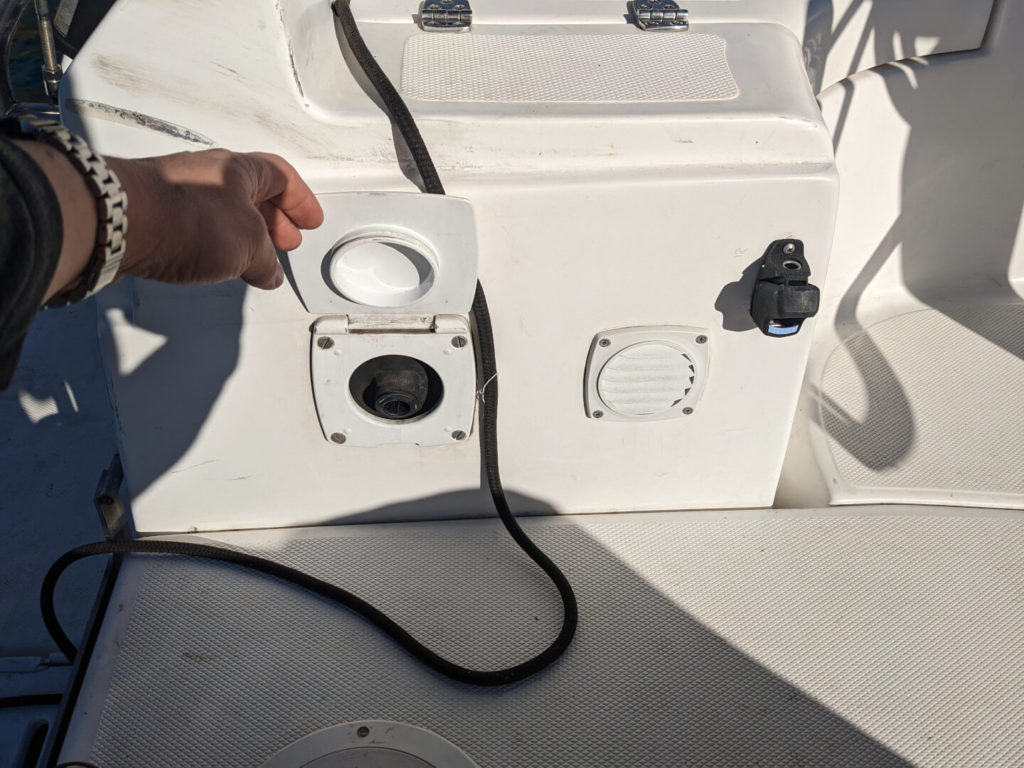
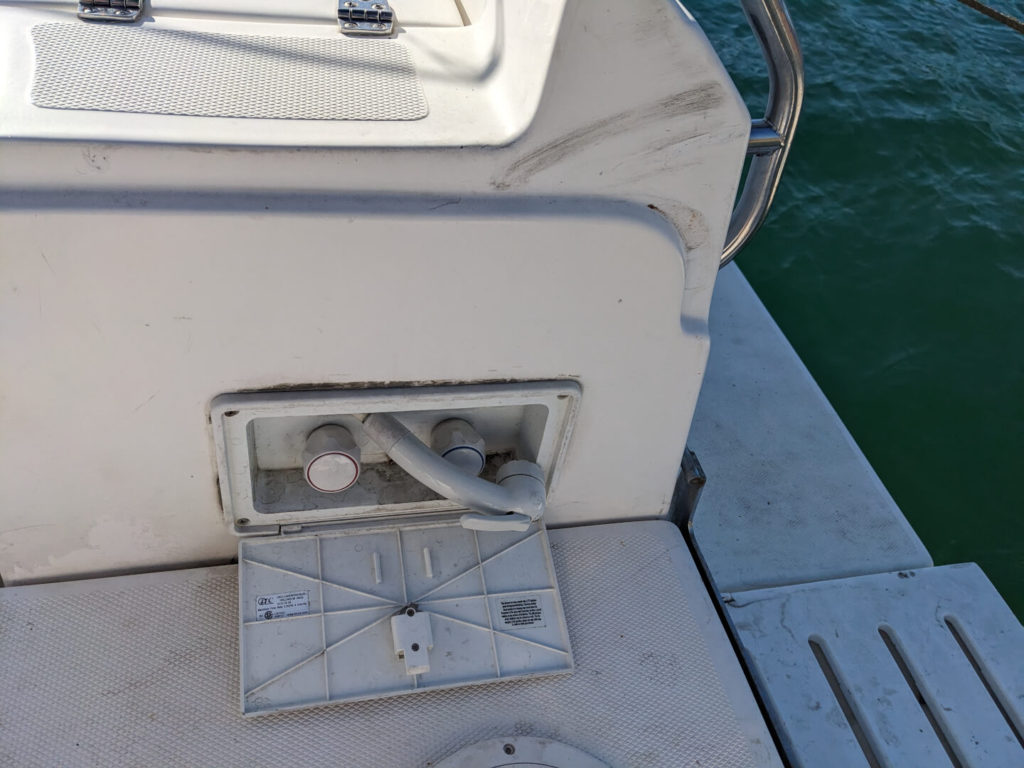
Ok, next mixed bag of innovation here is the transom storage. There are two huge, deep doors on the transom that open upward for some big, deep storage. While this storage might be ideal for wet snorkel gear and shorepower cords, it also comes with a few safety concerns. 1) it’s pretty precarious to access because there’s nothing to hold onto while you are hunched over working the latch and 2) its a very large potential hole to take on water in a following sea (waves coming from behind you), especially if a latch fails…because these bins open into the bilge.
Hunter 36 Bow
Up on the bow, the Hunter 36 has a very straightforward anchor locker. The windlass is operated with foot controls, which is much more convenient than plugging in a remote or running it up through the bow hatch.
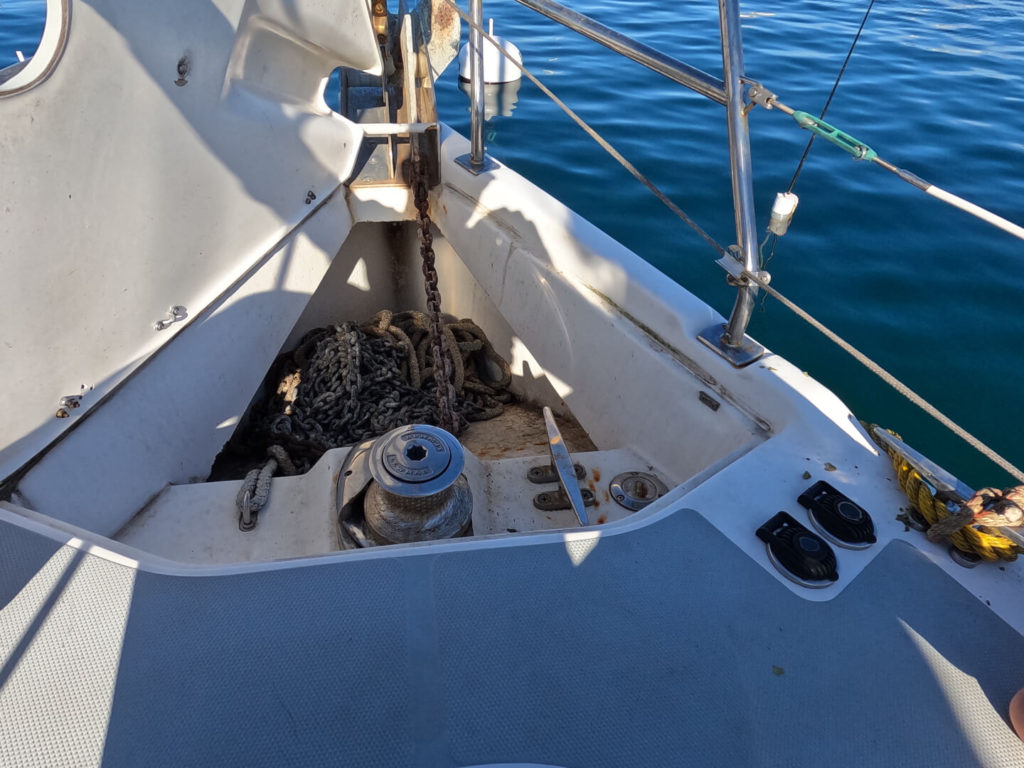
The galvanized delta style anchor is mounted on a bow roller with a bit of clearance to help keep it from leaving a mark on the way up. We were very impressed by our delta anchor’s sand performance in the Bahamas, but it was quite a bit bigger than this one.
One sweet trick that I hadn’t seen before was the water fill hole has a little hinged plate that you could lift up to twist to open instead of using a key. I’m always nervous about misplacing my deck fill key or dropping it in the water and this eliminates that issue. Unforuntately, our boat only showed this feature on the water tank, but the blackwater and diesel tanks still required a key.


Hunter 36 Interior
The Hunter 36 has a very typical layout for a sailing monohull of its size. Built around the companionway toward the stern you’ll find a stateroom on one side and the lone head on the other. The salon leverages the height and beam in the center of the boat. Another stateroom hosts a v-berth in the bow.
An incredibly welcome departure from the Jeanneau 43 DS we sailed last year was a complete lack of steps down below. The cabin sole (floor) was level from one end of the boat to the other. Given that, I was surprised that the ceilings and doorways were tall enough to clear my 6 foot head. Considering Hunter pulled this off in a boat that is a full seven feet shorter than the Jeanneau without the raised coachroof is a testament to great design.
Hunter 36 Galley
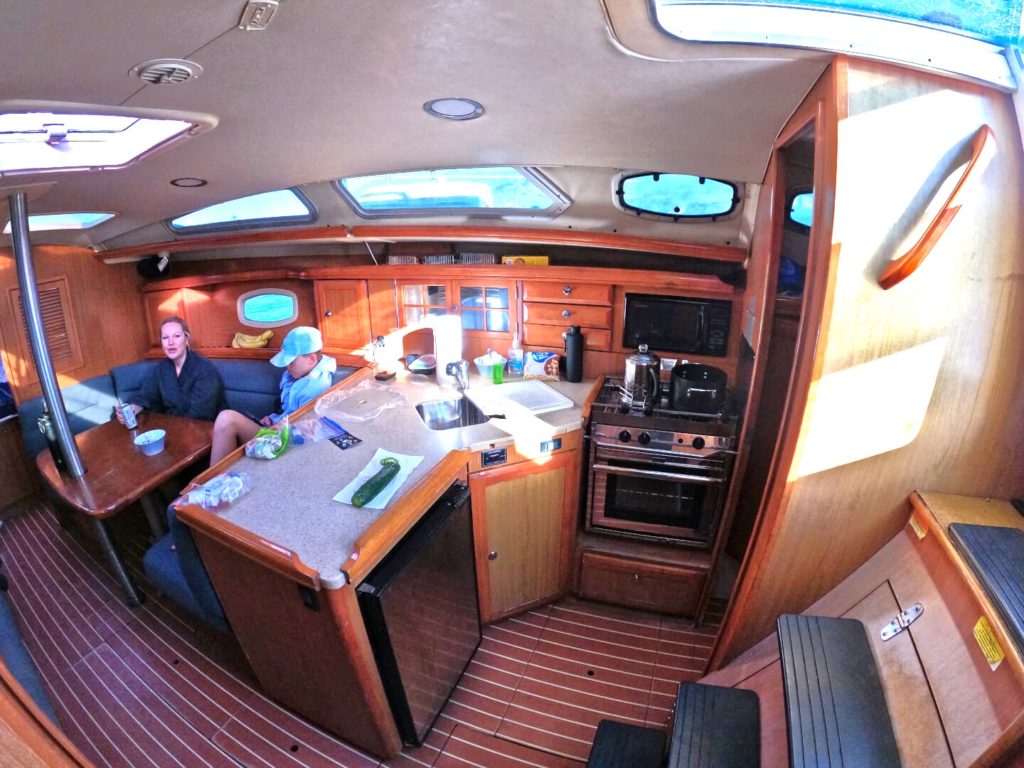
The L-shaped galley is integrated into the salon with one side of the dining settee (bench) backed against the cabinets. The wood trim extends above the the Corian countertop to form a lip that keeps things on the counter. This design is a simpler, lower cost finish than mounting stainless steel rails into the counter. One one hand, it keeps small things like pens and flashlights from rolling under the rails and off the counter. On the other, the lip serves as a tight gap to catch crumbs and soak up standing water.
As you can see in the photos there’s a mix of solid wood and cheap laminate in the cabinetry. The latter somehow picked up a gross green patina over the years that clashed with the other materials. Surprisingly though, the finishes applied to the solid wood have held up incredibly well.
Galley Storage
A modest bin is available in the floor for dry food storage, but a bit small for water.
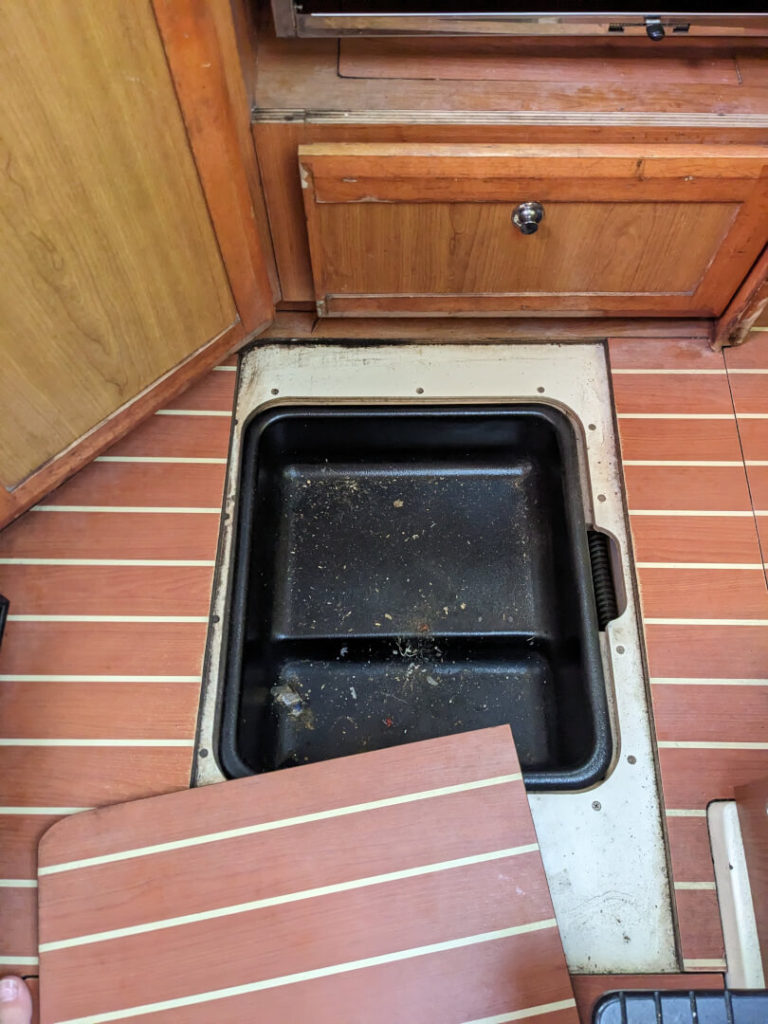
The galley isn’t large enough for much storage below the countertops. So, a small set of drawers above the counter make for a handy spot for cooking and eating utensils.
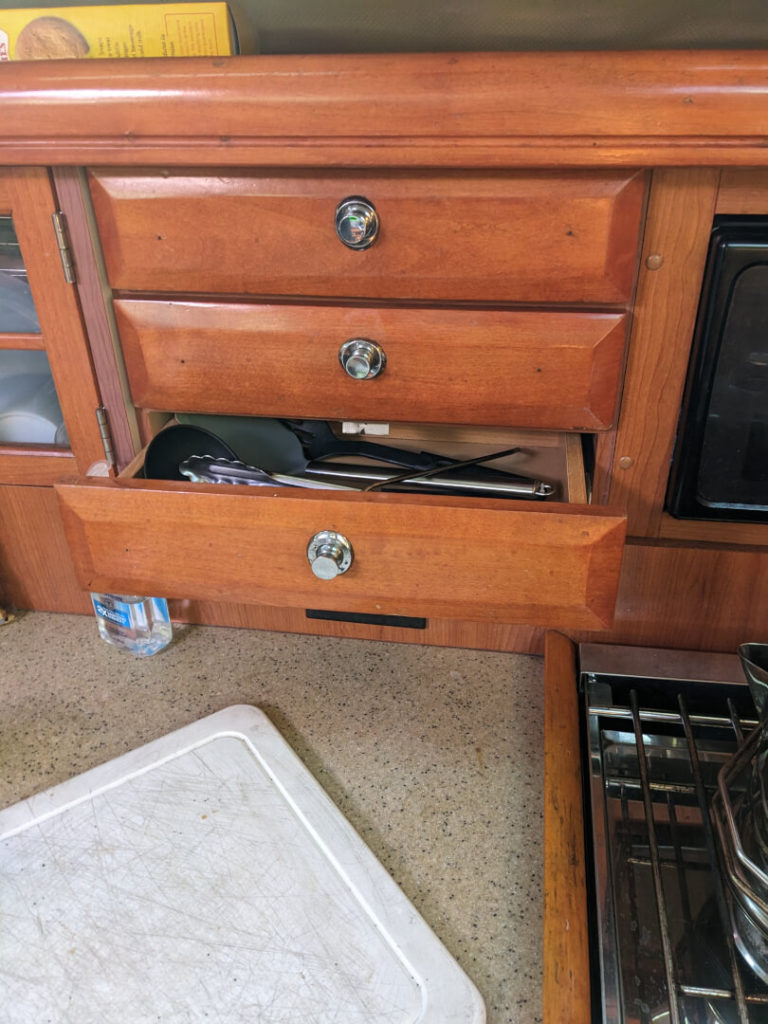
Next to the drawers is a hutch for tableware. I would prefer it to be solid wood rather than the opaque glass: hides the clutter better.
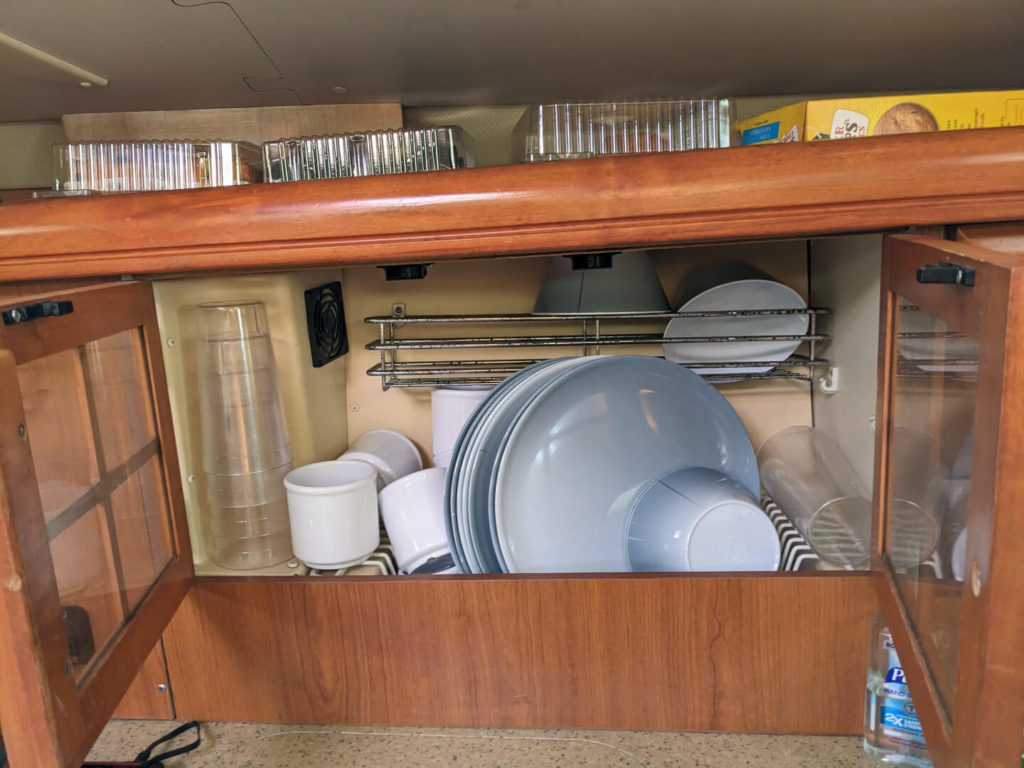
Two bins on rear of counter give you access to open space. We used one of the bins to store garbage, then learned that you must be very proactive in empty this BEFORE it fills up because the whole is smaller than the cavity. So you’ll never get a full bag of wet coffee grounds and egg shells out of the bin without ripping the bag open.
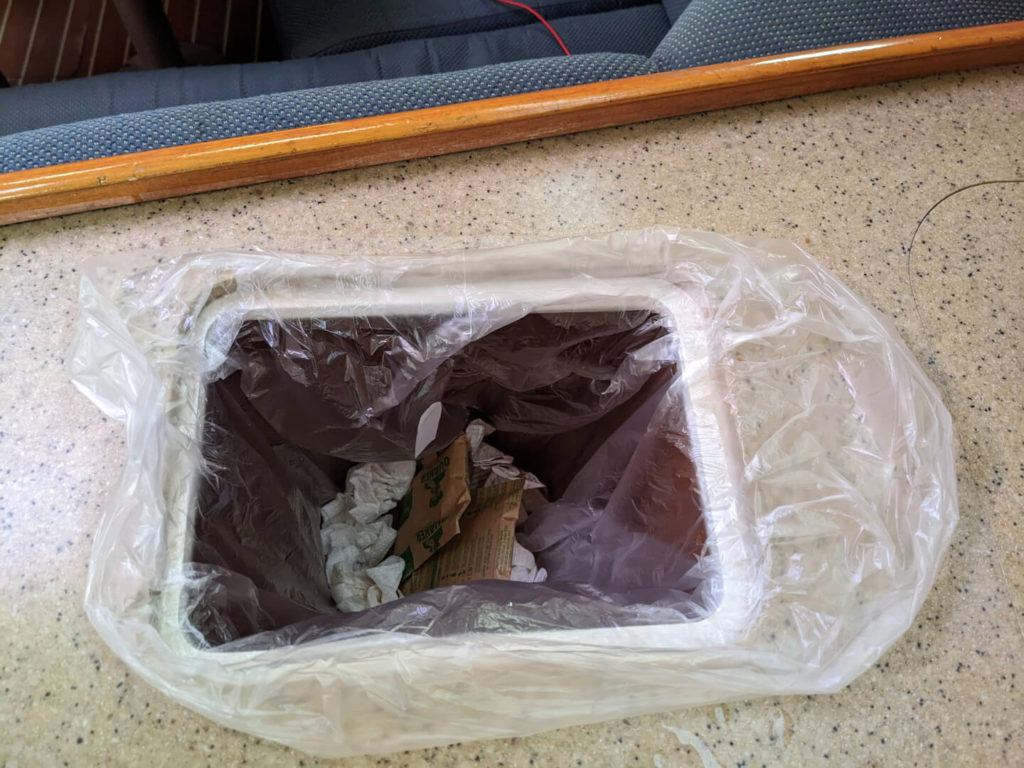
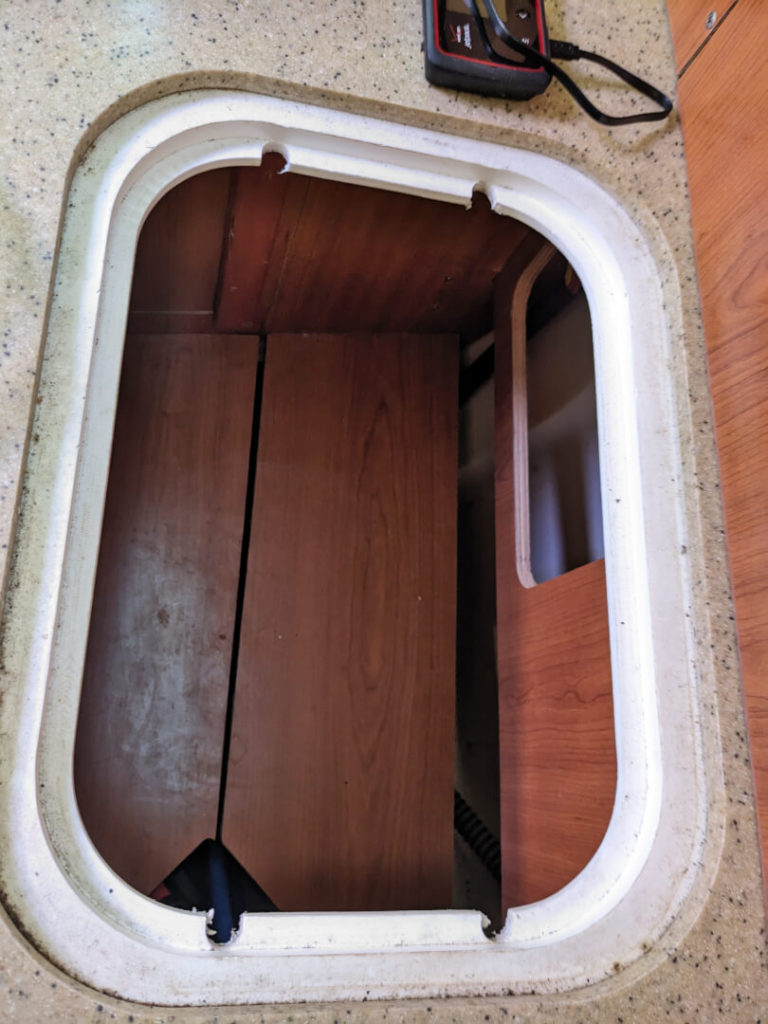
Galley Appliances
Range
I don’t think the Force 10 propane range on our boat was original: the gimballing lock on the stove didn’t align with the hole in the cabinets…so it couldn’t be locked in place. Sailboat stoves are often mounted on a gimbal that allows it to swing in order to stay level when the boat is heeling under way. That’s a nice feature for long range cruising, but mildly annoying when at anchor…hence the lock…that did not work on our boat.
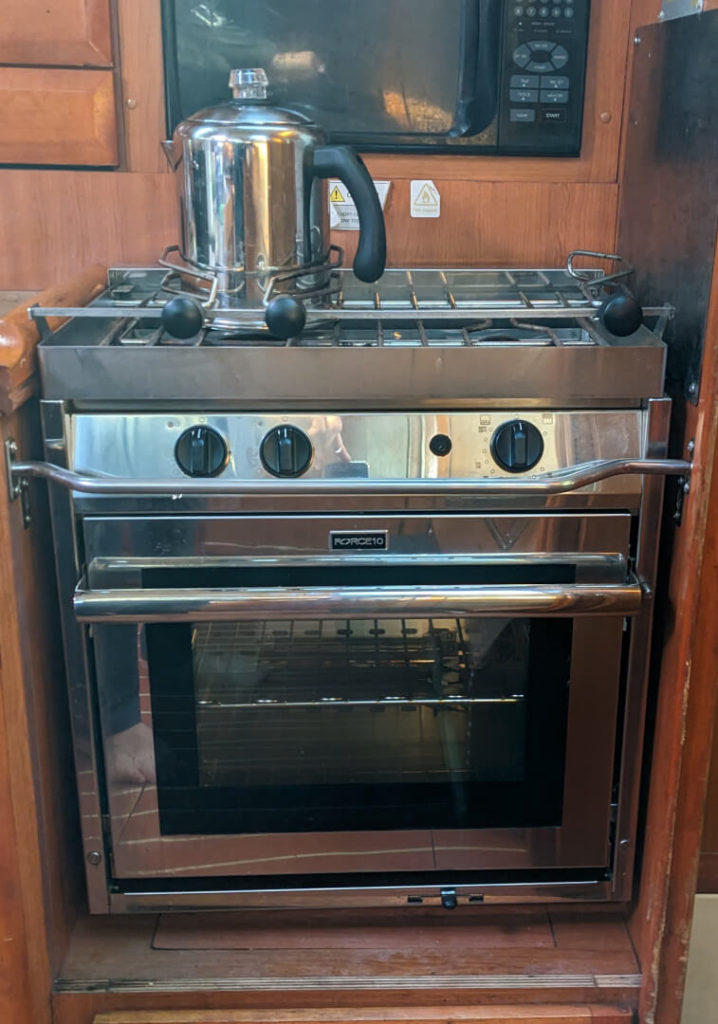
The stove was equipped with two burners, one smaller than the other. The larger burner would not stay lit. The dockhand told us he had just cleaned it, so it probably had some water in there that was clogging it up. Well, at least we had one burner, which was all I needed to run the percolator for my oatmeal and coffee. Beyond that, we had already planned to eat on shore..
Refrigerator

The refrigerator is spacious and did a great job holding temp after we lost power for two days. It has a freezer that had no problem holding our ice. The only beef I had with it was there was no drain. So, if you’ve got a melting situation, you’ll have water on the floor. The refrigerator could be set cold enough to freeze cucumbers.
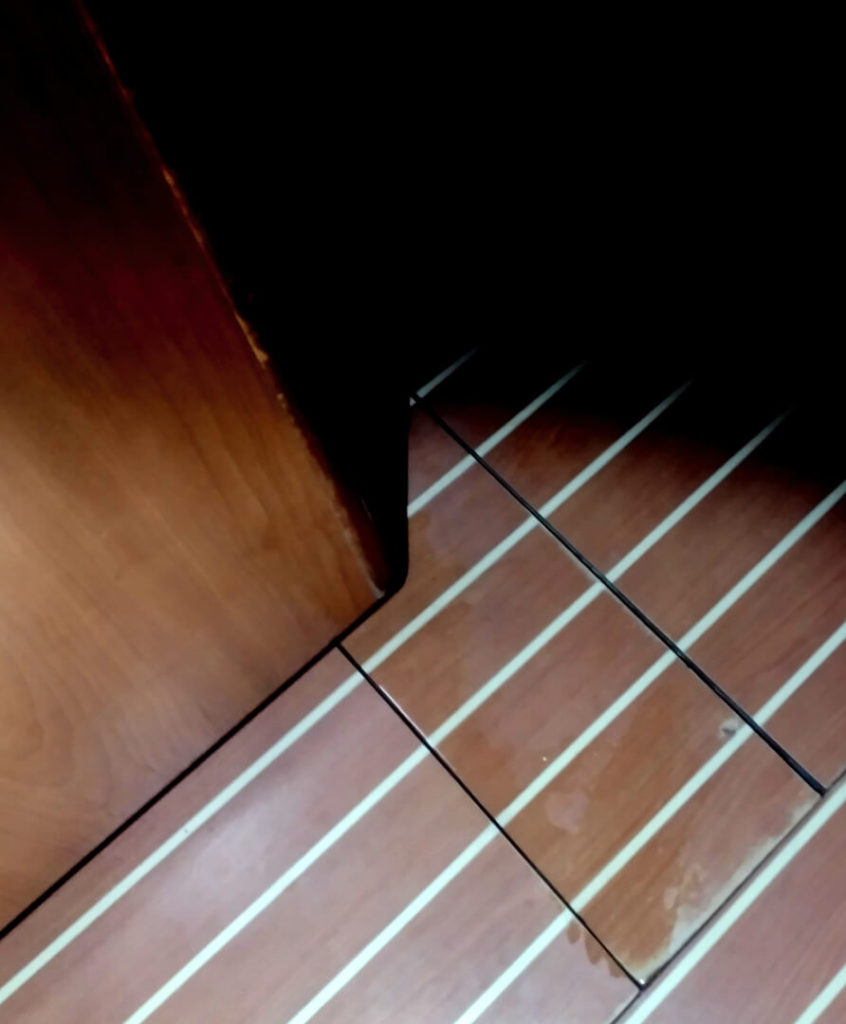
Microwave
The boat has a microwave. It only works on 110 volts. So you can use it at the dock, or if your boat is equipped with a generator. Ours was not, so we didn’t use it. I guess you could use it for storage too. Sometimes I wonder why there is so much 110 volt crap on boats with no generator or inverter. Do boat builders assume the owners will spend most of their time at the dock plugged into shorepower? Or is it just a cheap way to make it look like the boat comes with lots of gadgets? I mean, this Walmart grade microwave is probably one of the cheapest things on this boat, but it makes the kitchen look more complete at the boatshow.
Sink
The two bin sink had a cutting boat cut to fit over the larger bin. This increases counter surface area while still allowing access to the sink. We left cleaning supplies under the cutting board and relied soley on the small sink to clean dishes. If we had done more cooking, we would have needed the larger sink at some point to clean pots and pans.

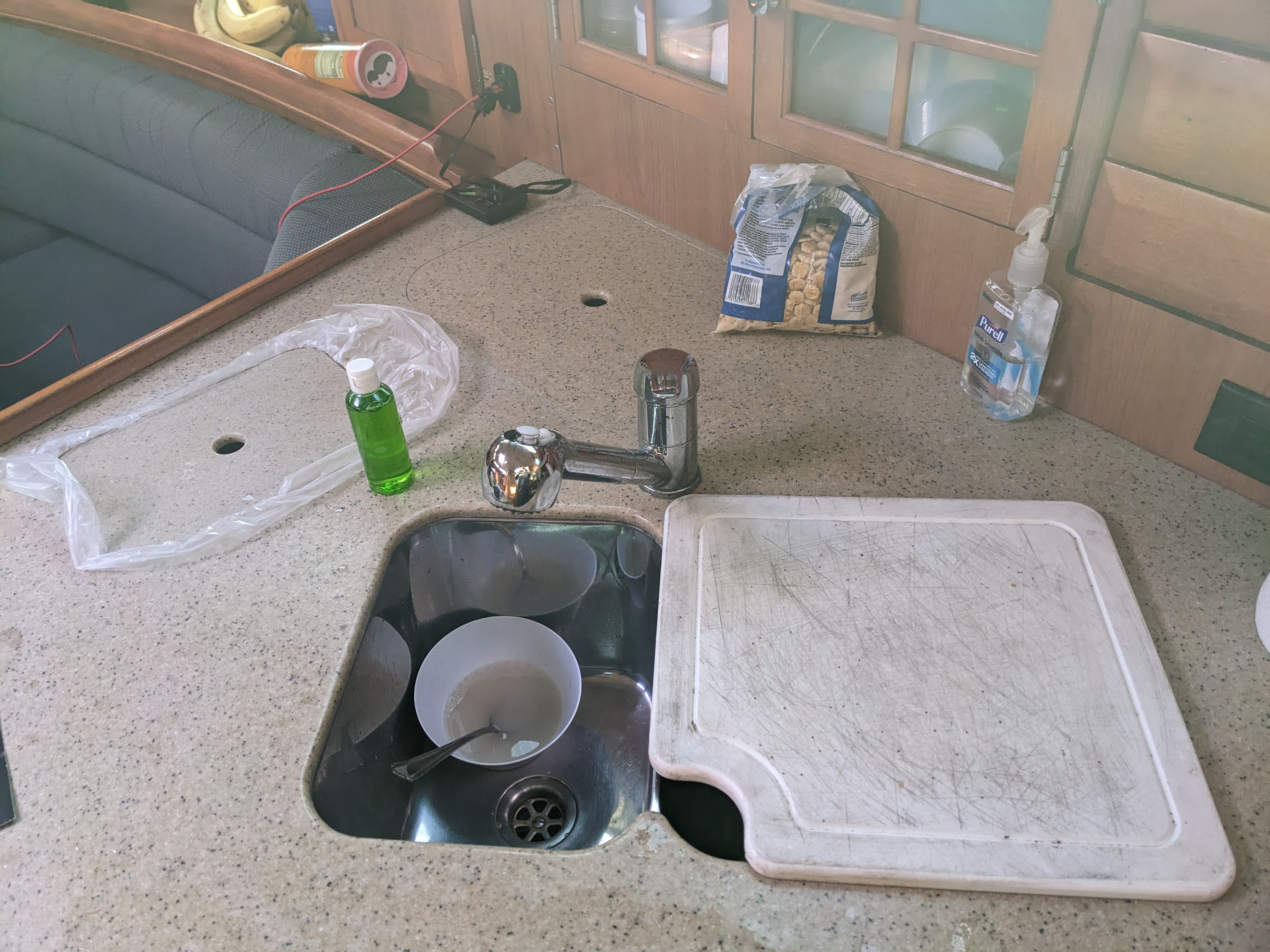
The sink was equipped with pressurized fresh hot and cold water. It was not equipped with a footpump,
Hunter 36 Salon
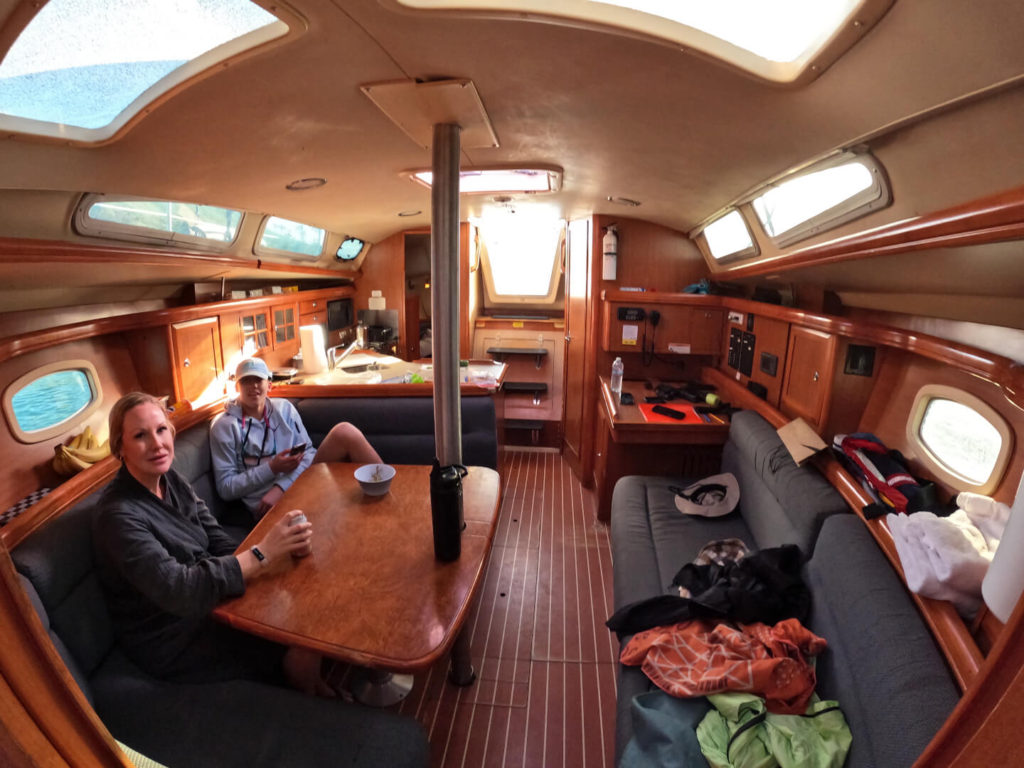
The salon is very spacious with lots of natural light. This lanky six foot tester could stand up straight without getting bonked. One the starboard (right) side a U-shaped dining can seat four very comfortably. The table is obstructed by the mast that passes through in the least obtrusive way possible across from the seating area. A generous bench lies on the port side that doubles as a backless seat for the nav station. Firm wooden handholds run the length of both sides just below the main windows. Shelving runs the length of the cabin above and below the cabinets: the top run is wide on the cabinets and narrow on the windows. The bottom run is opposite. There is no shortage of flat spots to set your crap in here.
The nav station faces the stern. The end of the port side bench serves as a seat for the desk, saving space over a dedicated seat at the expense of a seatback. I’m picky about comfy seating, but had no issue with this design. This colocation of the nav station also means it might double as a flat surface for food and beverages…which could quickly turn your paperwork into a sticky situation. What I really love about this nav station is there’s just a ton of nooks and flat spots for setting all of your crap. A tight ledge near the 12 volt outlet is a great spot to wedge a few charging phones, wallets, and eyeglasses without taking up much real estate. We used the high shelf for quick access to items the crew may need: emergency VHF instructions, mooring documents, horn, and handheld VHF.
As you’d expect, the nav table lifts to reveal storage for maps. Forward of the table there are two big bins that can hold stuff, what stuff its good for I don’t know. Then a cabinet below the nav table is a great spot to keep tools and fluids.
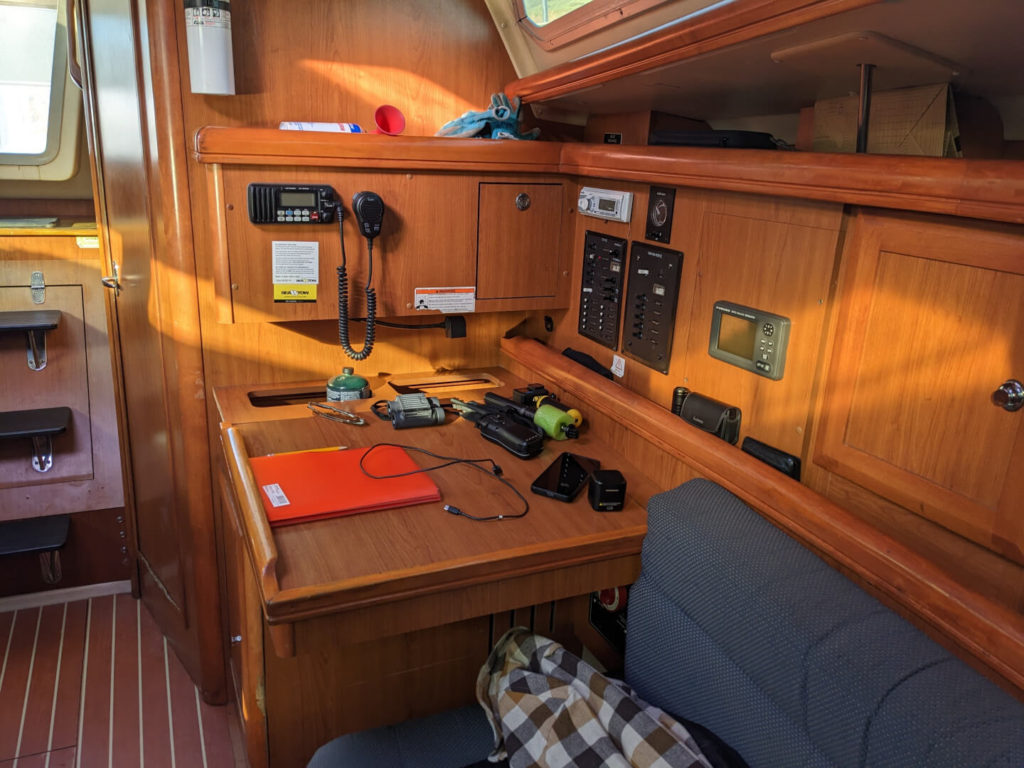

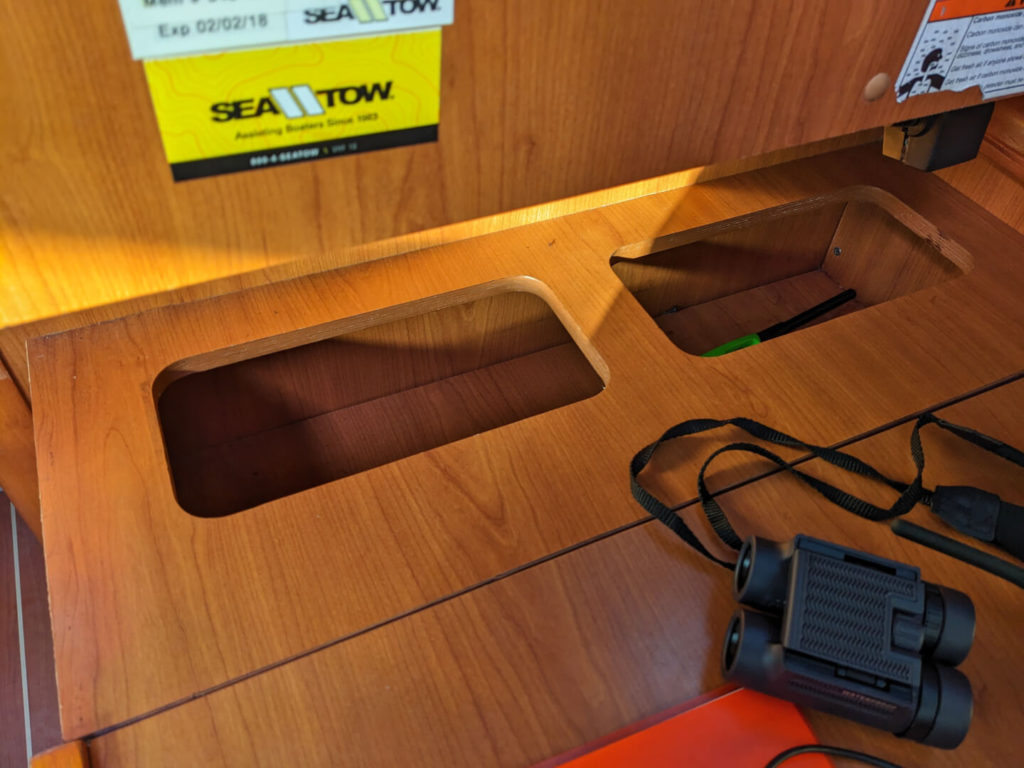
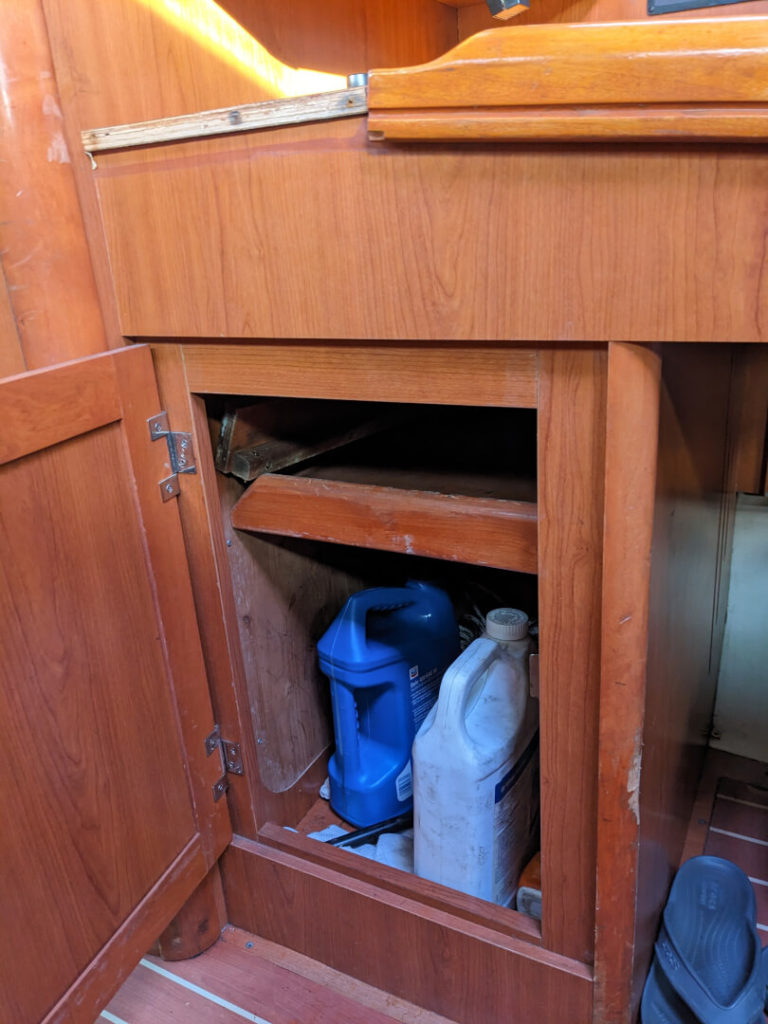
You’ll see in some photos, our rental came with a propane tank in the nav station. SMH. The only place propane should be stored is in a dedicated propane bin that vents outside the boat. Propane is heavier than air and can build up in the bilge, causing a nasty fire risk.
Hunter 36 Staterooms
Forward Stateroom
The forward stateroom is the smaller of the two, but still very ample in size and storage. The V-berth is solid and mounted at a reasonable height (no climbing).


Storage includes Hanging lockers on both sides and generous shelving below the v-berth. The springs in the hanging locker latches were worn out and did not stay closed.
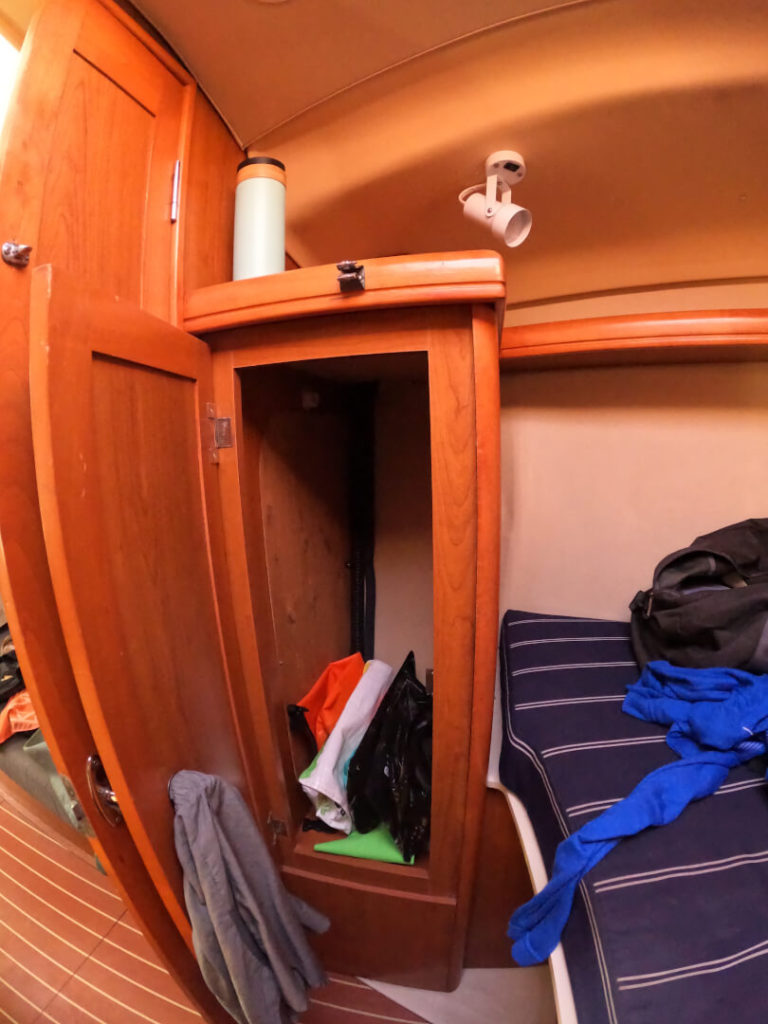
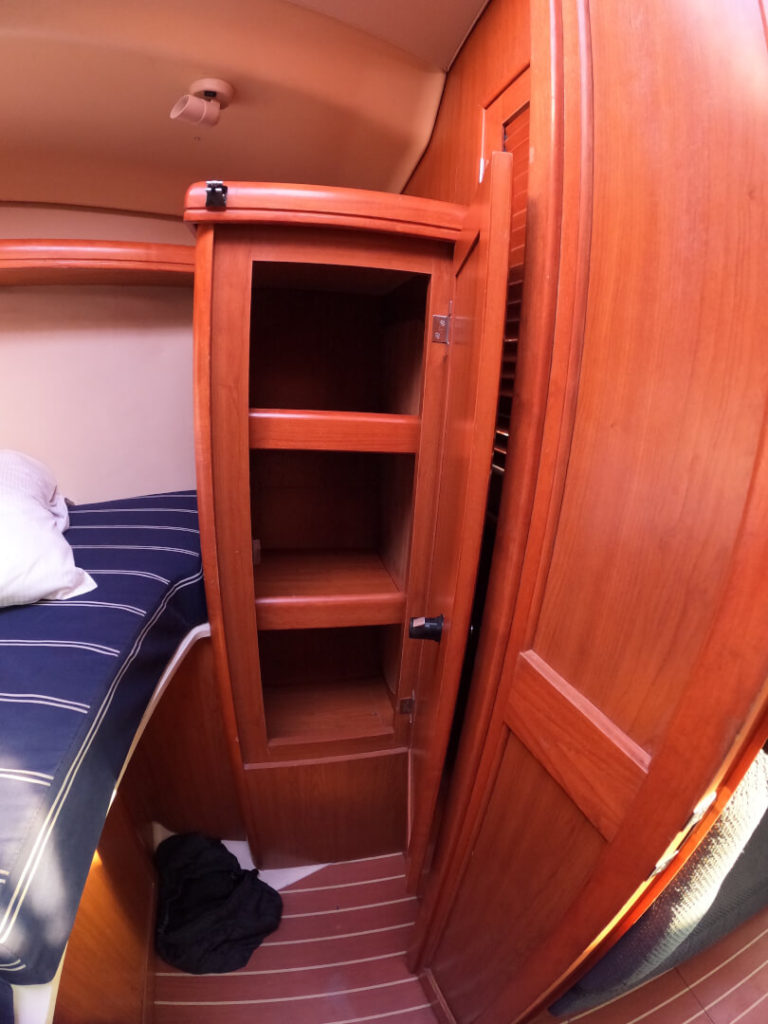
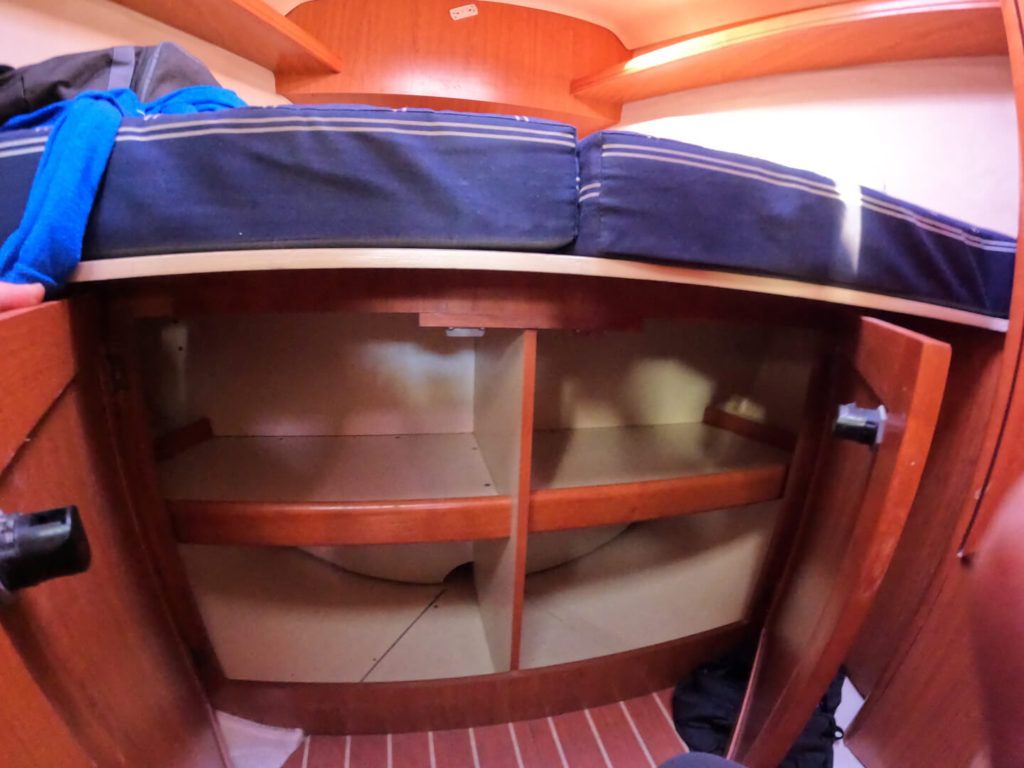
Like in the salon, solid flat surfaces span the length above the cabinets. Outlets on one side provide a great place for charging electronics.
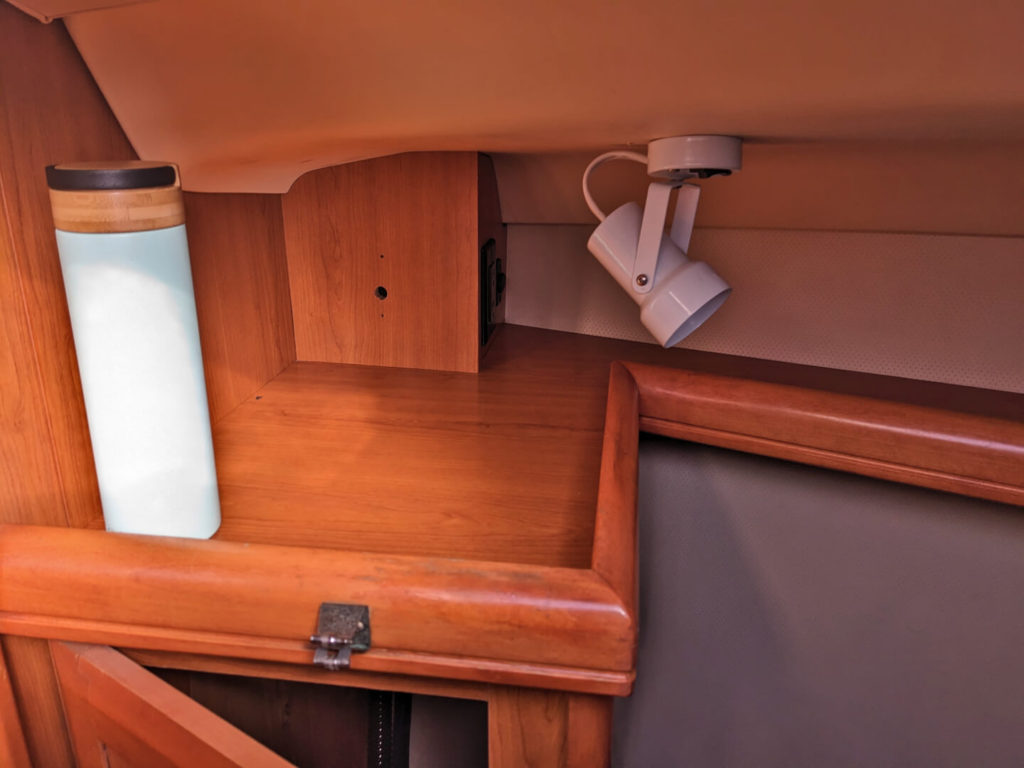
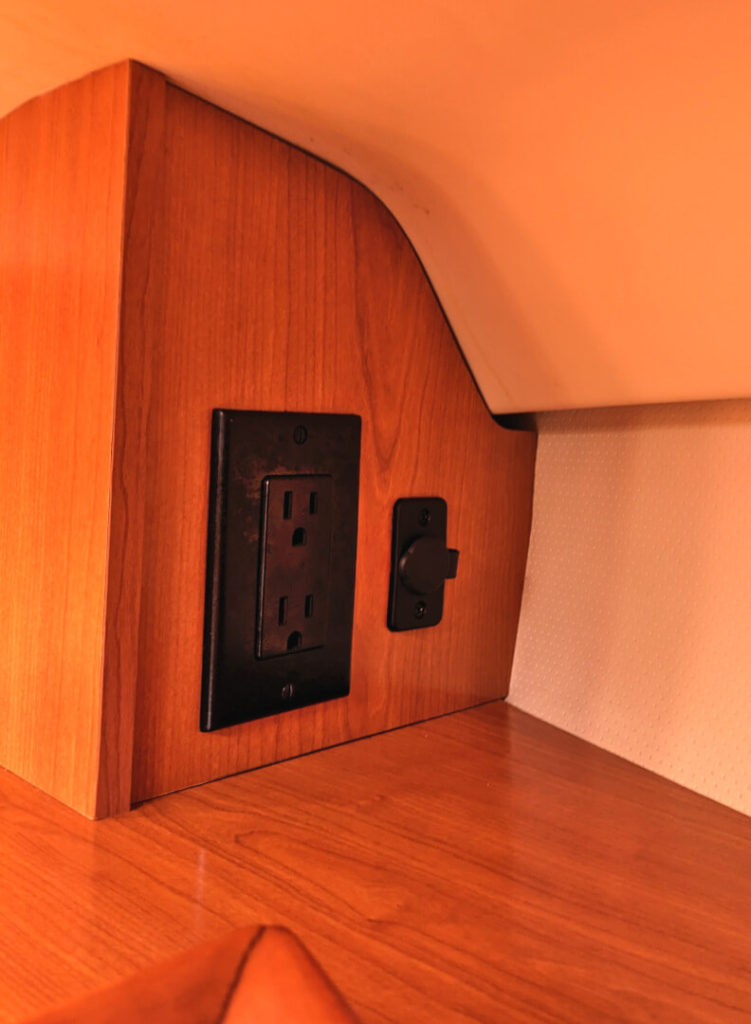
You’ll only have one window, the hatch. However, you’ll be using this primarily at night (unless long range cruising) and the electric lighting is very thoughtful. Two overhead lights are individually switchable, plus you’ve got a reading light for each side of the bed…if you’re into that sort of thing.
Two small french doors allow for a large doorway without taking up too much space when opened. Adjacent to this was the oddest thing: a slatted window into the salon. We thought it was good for playing horse, but otherwise unclear as to its purpose.
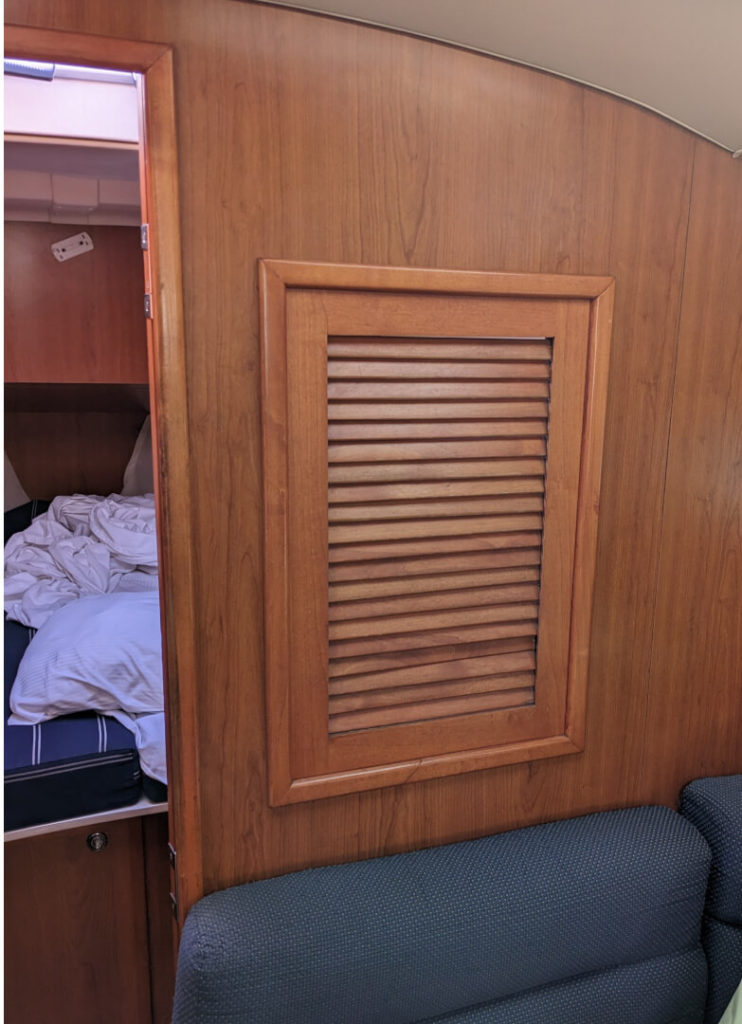
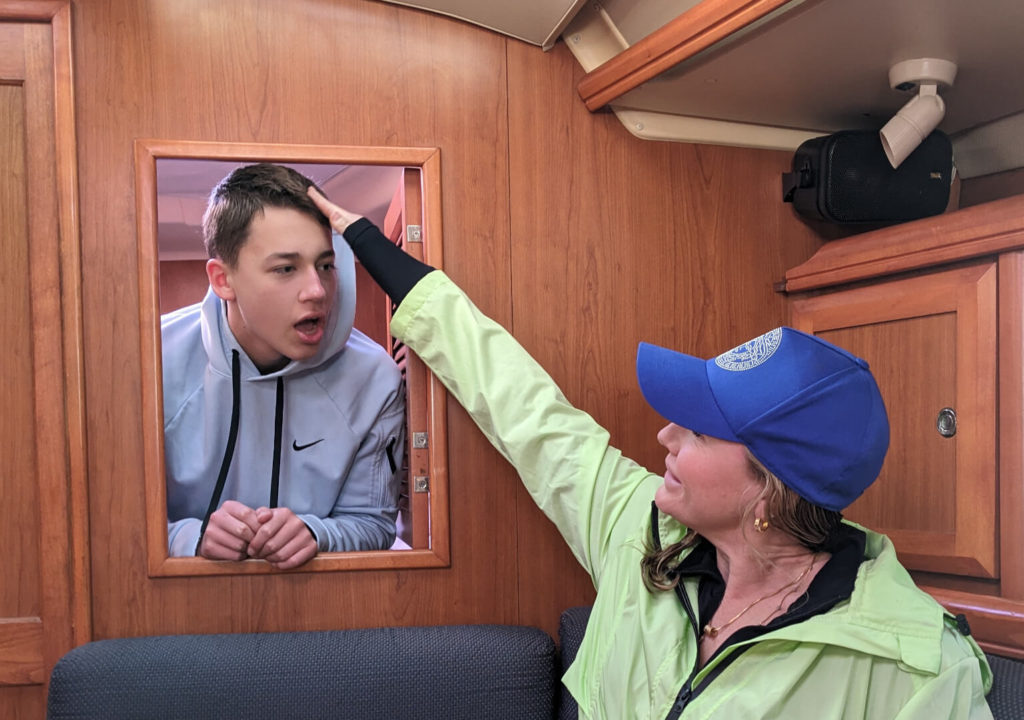
Aft Stateroom
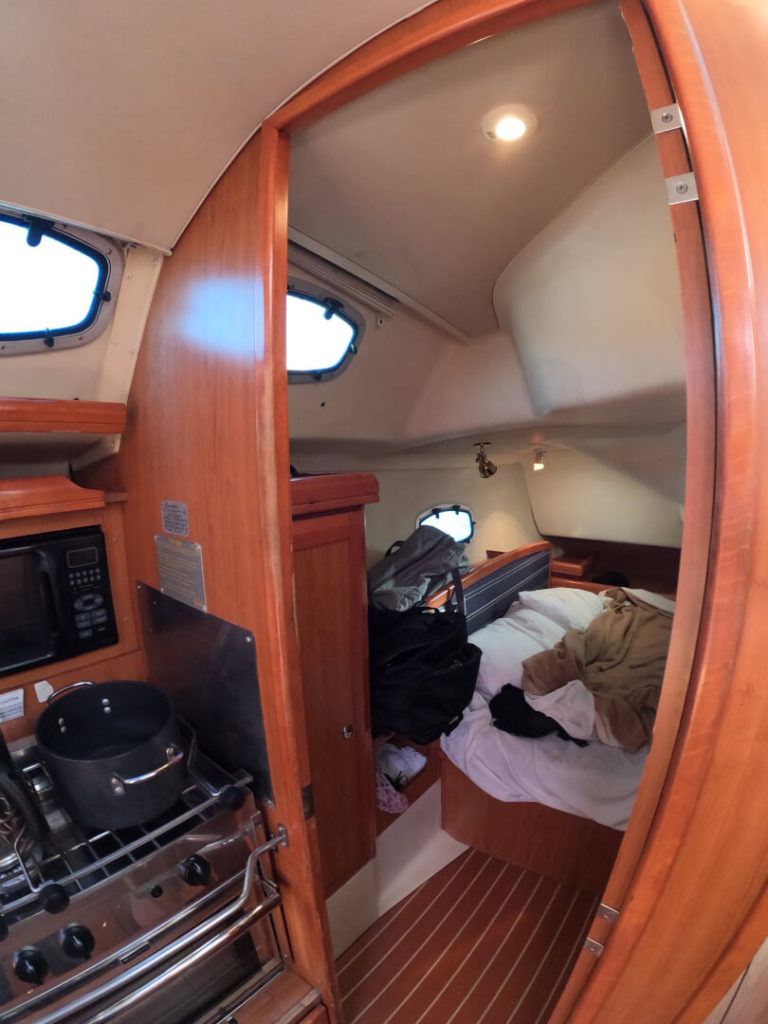

The berth in the aft stateroom is massive for a 36 footer. It’s approximately king size, significantly wider and of similar length to our queen bed at home. To shoehorn a bed this big into a boat this small, the entry is limited to about 40% of one side of the bed. This not only makes a real chore out of changing sheets, but the inboard crew member will have awkwardly climb over the outboard crew member’s face to go potty or wake up early to put the coffee on. If there’s a bright side its that the bed is mounted pretty low, so you don’t have to use your bedmate as a handhold on the way in or out.
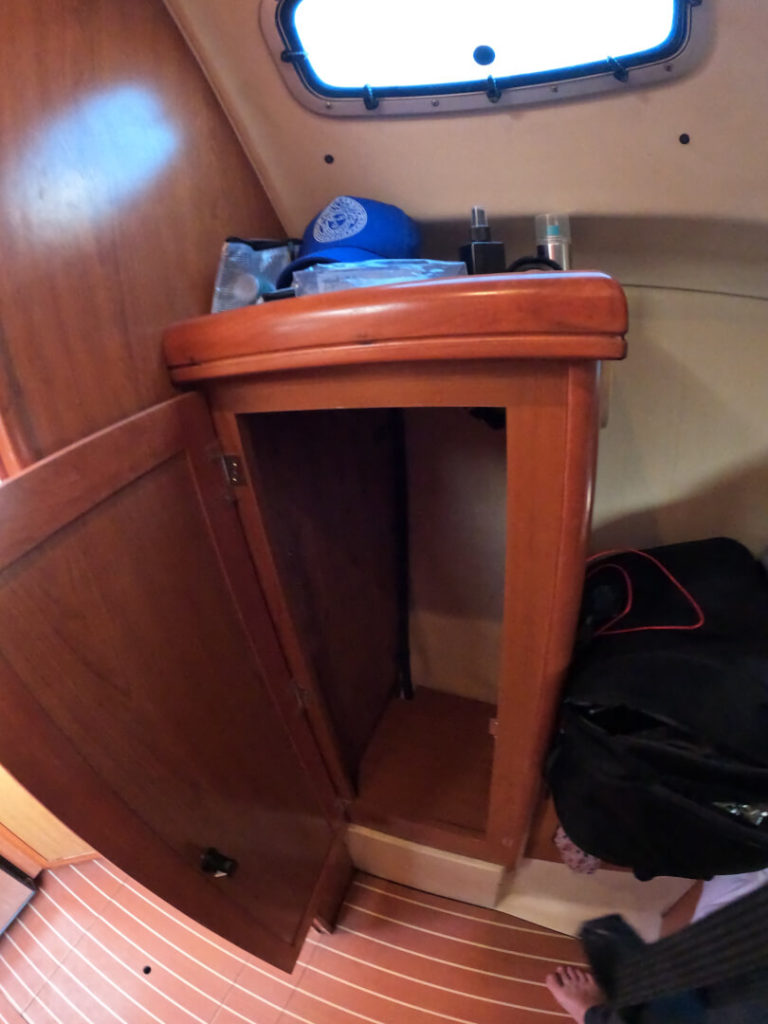
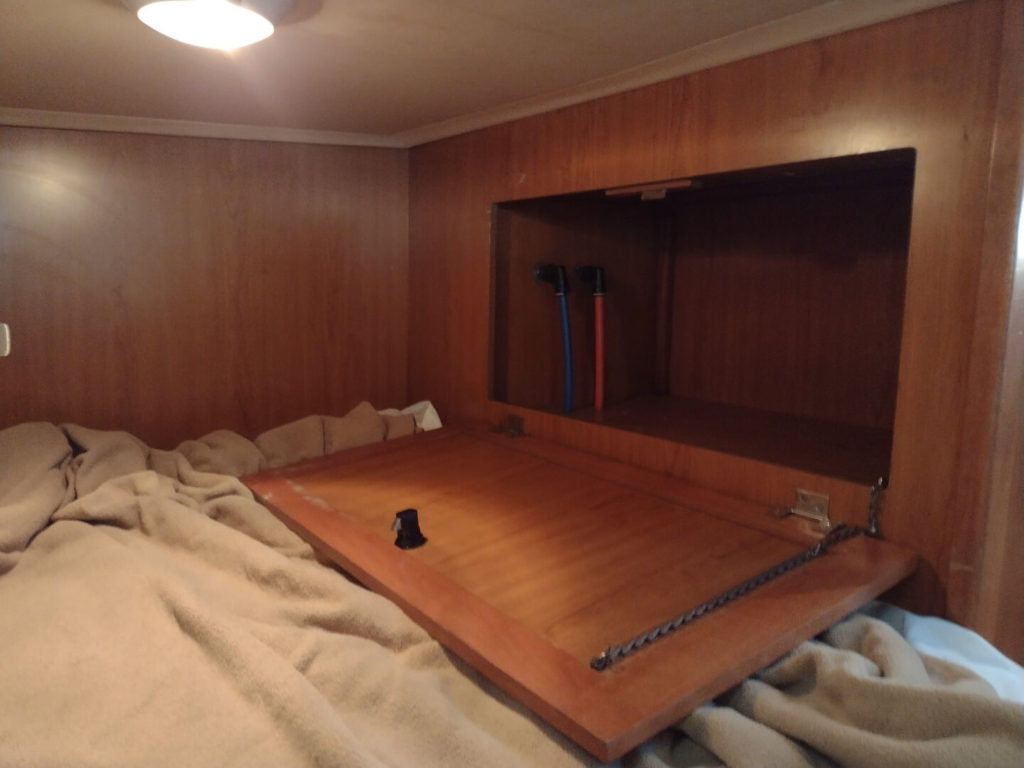
While the berth in the aft stateroom is a clear winner, storage is much more generous up in the bow. There is flat space above the hanging locker and long wide spot on the far side of the bed that could swallow a small library of books. But the bedside ledge has no power outlets and the lcoker ledge can’t be reached from the bed. The hanging locker is comparable to the bow, but there’s no cupboards, only one moderately generous cubby above the engine that can only be accessed by climbing into the bed. There’s also a 6″ wedge between the headboard and the hull that’s a great spot for stuffing duffles.
There’s not much floor space for getting dressed in here, plan on making that a solo afair.
I’ve got two beefs with sleeping on the Hunter 36 that may only apply to readers over 40:
So many times I’ve heard other boaters complain about how much noise a boat makes in the water while at anchor and how it keeps them up at night. Meanwhile, I’ve hard salty old ex-navy sailors wax on about how there’s nothing more restful than a ‘night on the hook’. Previously, I’ve had trouble sleeping for fear of dragging anchor, but always found comfort tied to a mooring in protect water like we were on Perfect Partner on Catalina Island. This boat, at this mooring finally got the best of me. Possible causes of this phenomenon:
- The last few feet of the stern poke out of the water at anchor, providing a spot for water to slosh up against the aft stateroom.
- This was our first time on a Catalina style mooring, which doesn’t allow the boat to shift with the wind…whether or not this contriubted to the noise, it definitely resulted in a lot of rocking and rolling when the wind rolled through.
- Perhaps the hull materials on the Hunter 36 allowed for more transmission of noise, you know because ‘we’ hate Hunters because they are poorly built with poor materials (a bit of sarcasm, I think)
Okay, with one of my old man champagne problems out of the way, lets move on to the Prince and the Pea. The foam mattress on Perfect Partner was incredibly thin. I had to turn every hour or so because whatever part of my body was facing down got sore against the wood platform underneath. This could be due to the age of the mattress, or, again, we can hate on Hunter and blame their cheap quality!
Hunter 36 Head (bathroom)
The head on the Hunter 36 is located just to port (left) of the companionway steps. This makes it easy to access while under way and a bit less bumpy than if it were further forward. The size of the head is generous.
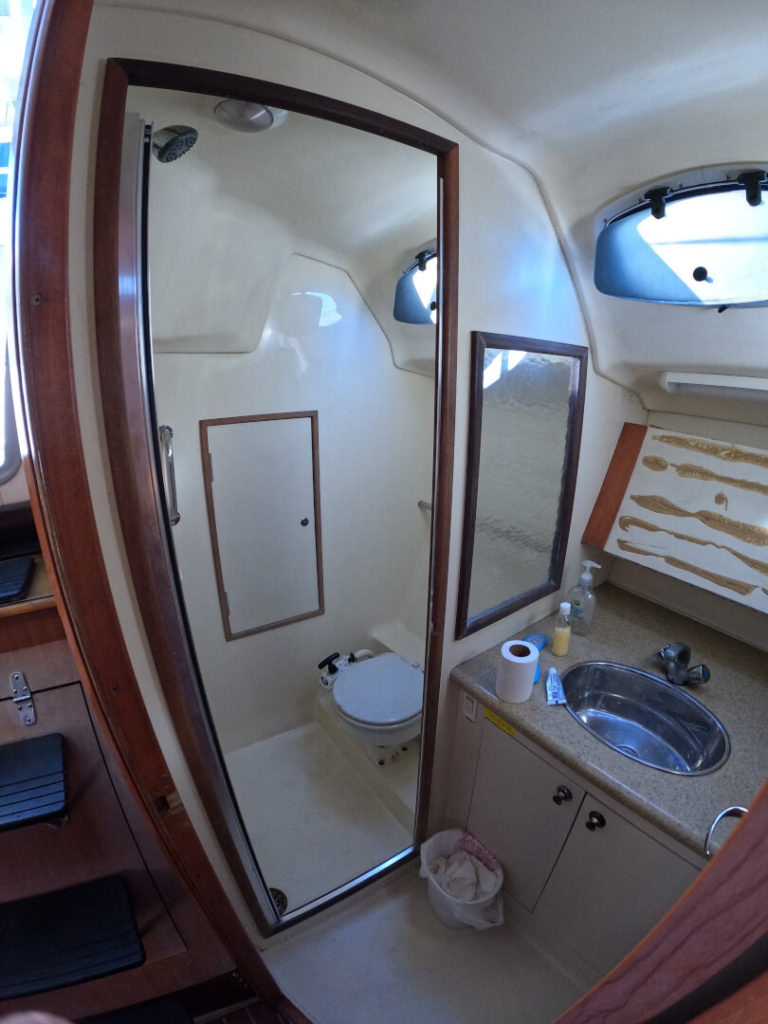
There’s a dedicated stall for the shower and toilet behind an opaque door. While this means your feet will be in the shower when doing your business, it gives you a bit more room for showering. This layout also allows for crew to use the sink/vanity while the shower/toilet is in use. A nice feature with only one head on the boat.
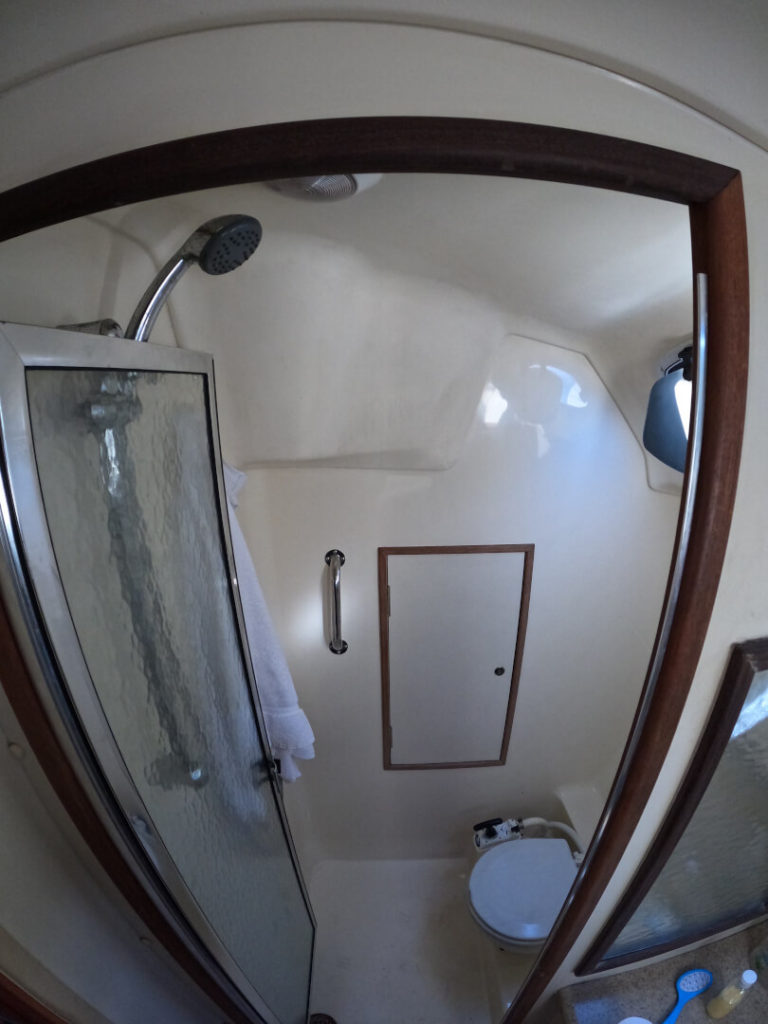
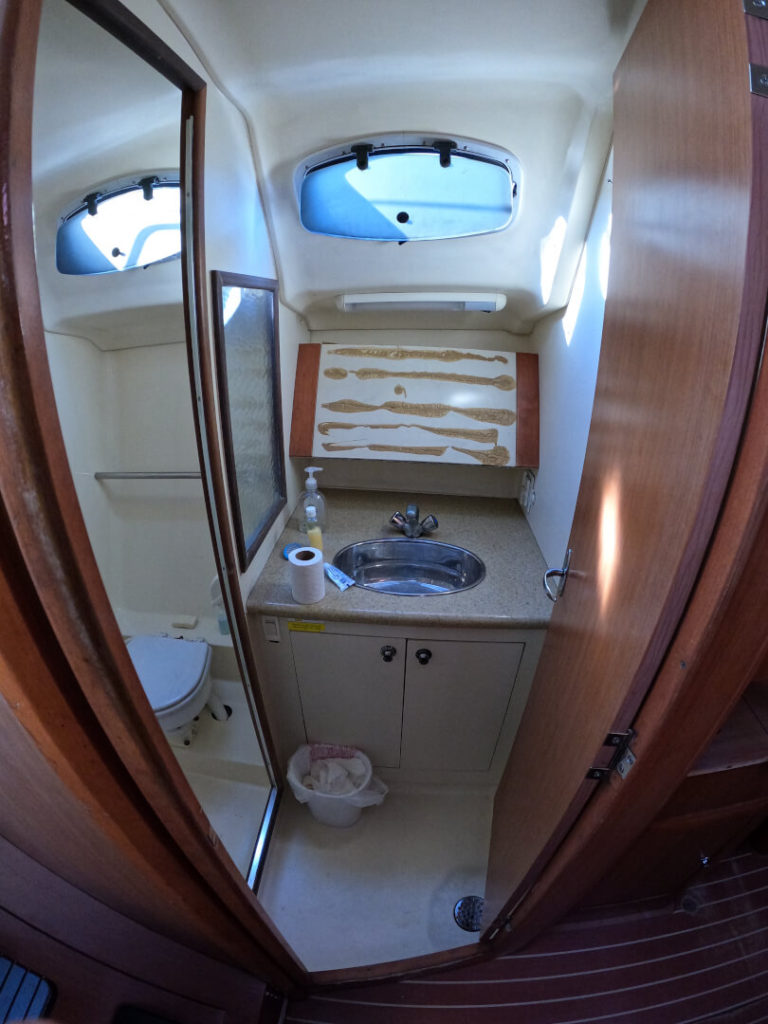
The throne is very well designed here. Its close enough to the floor to get good traction with plenty of room out front and to the sides to spread your legs. You can also take advantage of closing two doors behind you if your one of those people that needs a little extra layer of privacy…oh, and a dedicated opening hatch to keep the fresh air circulating.
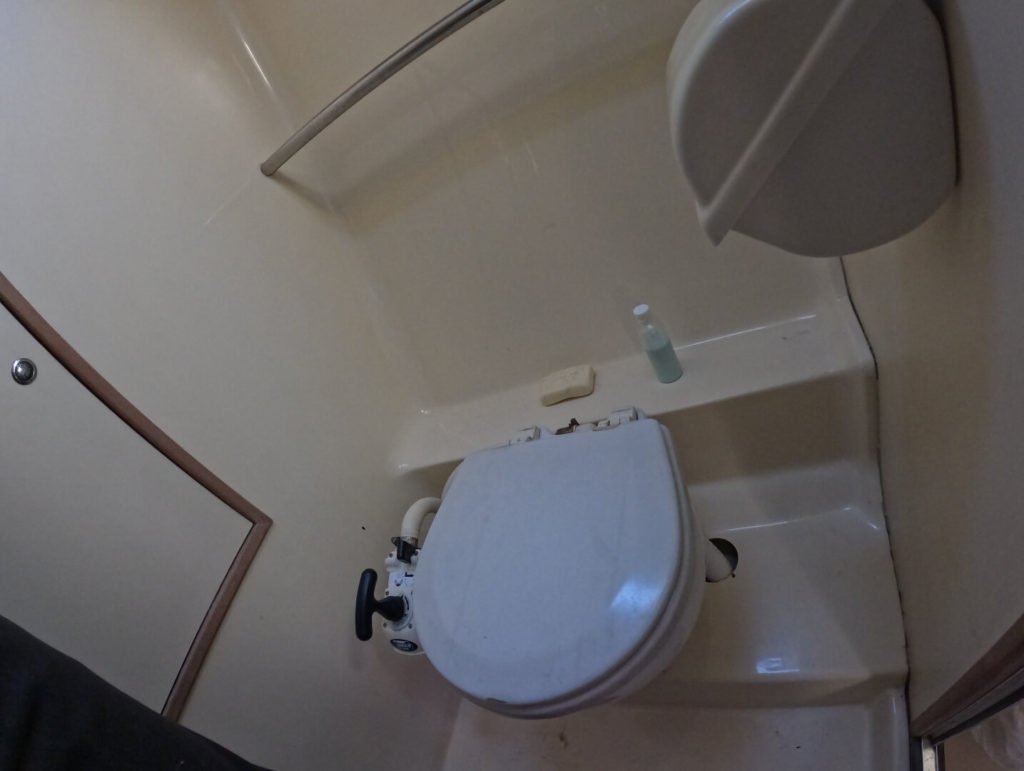
The shower is spacious enough to get your arms up and out, and bend over to work all the stink zones. There’s also a thoughtful ledge and towel bar available in the unused space behind the toilet. There’s also a set of towel hooks and a hand hold next to the shower wand, which has a pause button to minimize water use. Perfect Partner was equipped with a water heater that we couldn’t get to deliver hot water. I tell you what, showering with cold water on a chilly morning really helps cut down on water consumption. So we did not come close to having to buy water at Catalina Island. At the other end of the cycle, the Hunter 36 has a lip to keep the shower water in its place, and a drain on both sides of the lip, just in case it doesn’t. The sump operates automatically.
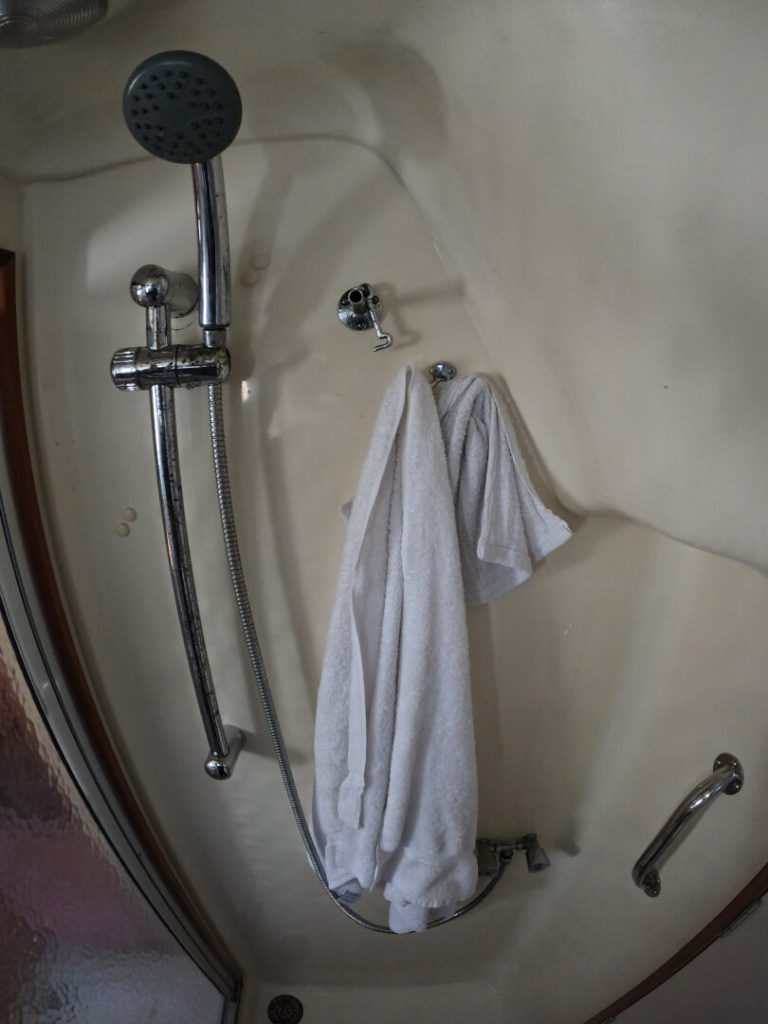
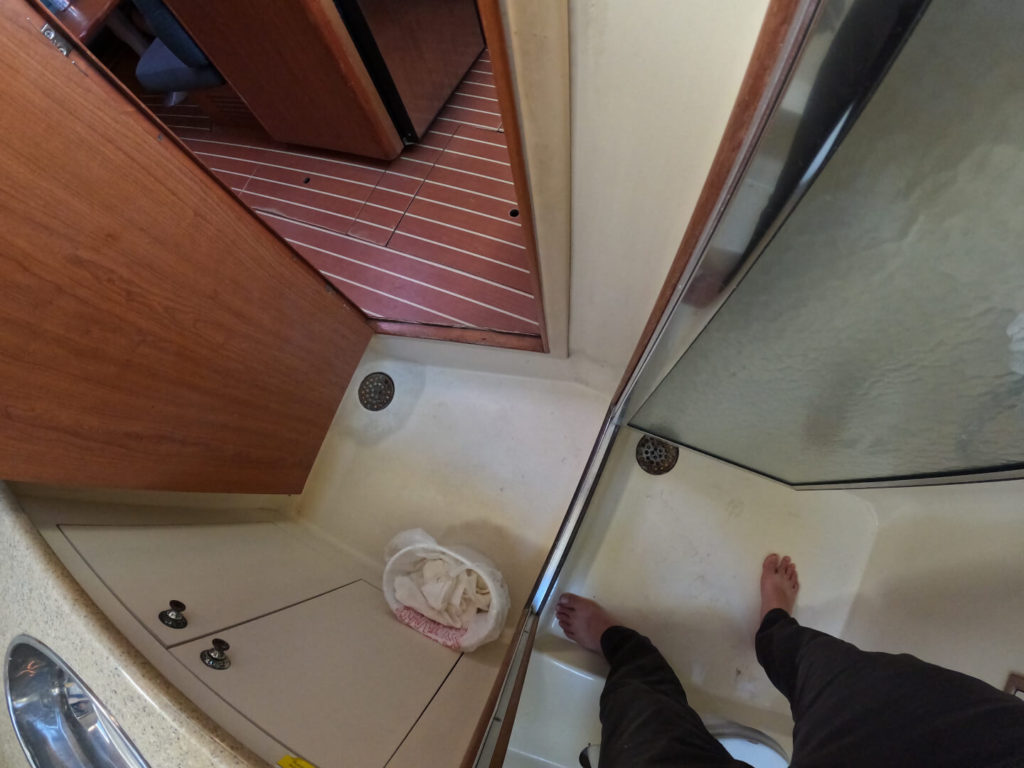
The vanity has ample storage underneath and behind where the mirror used to be. 12 and 120 volt outlets are conveniently mounted on the right side of the vanity.


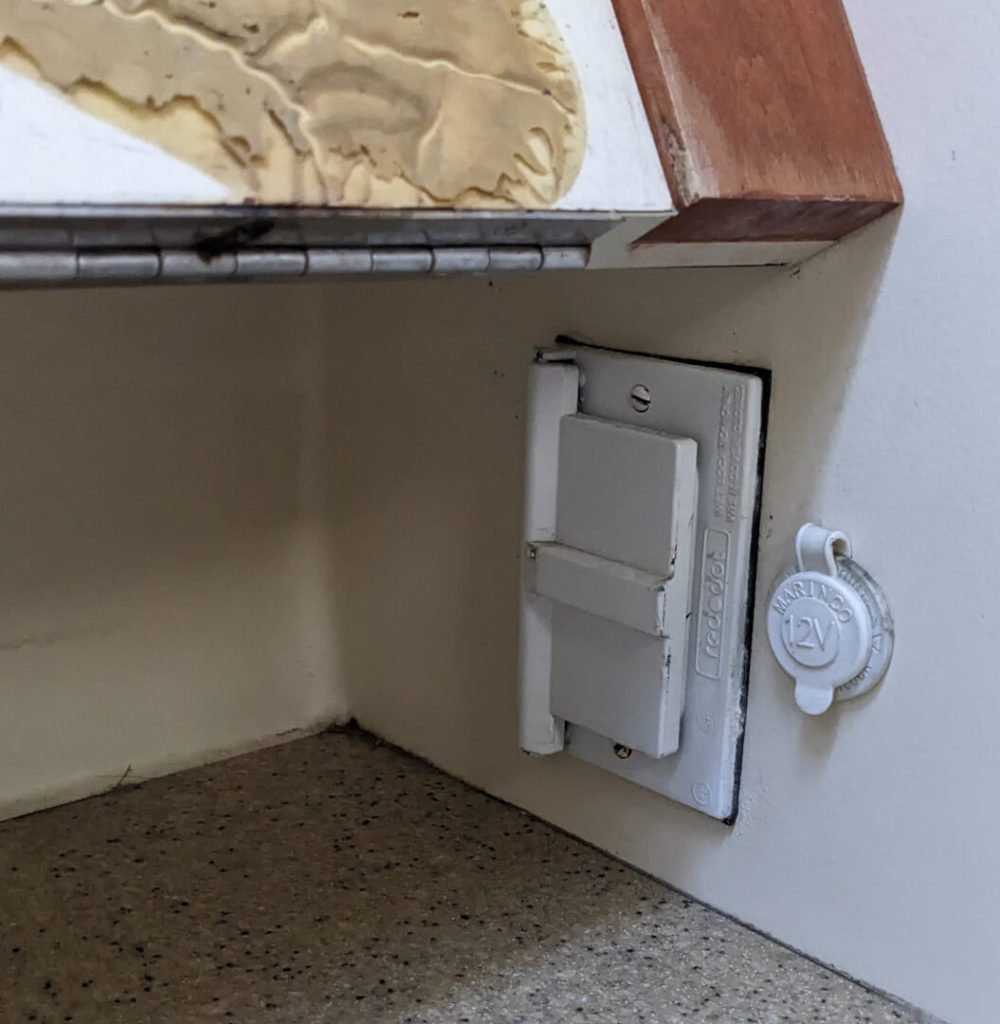
A very large locker is located behind the shower. While the storage is welcome, I’m not a fan of the location. First, you’ve gotta trapse through the shower to get to it, and the high humidity will limit what you can keep in there.

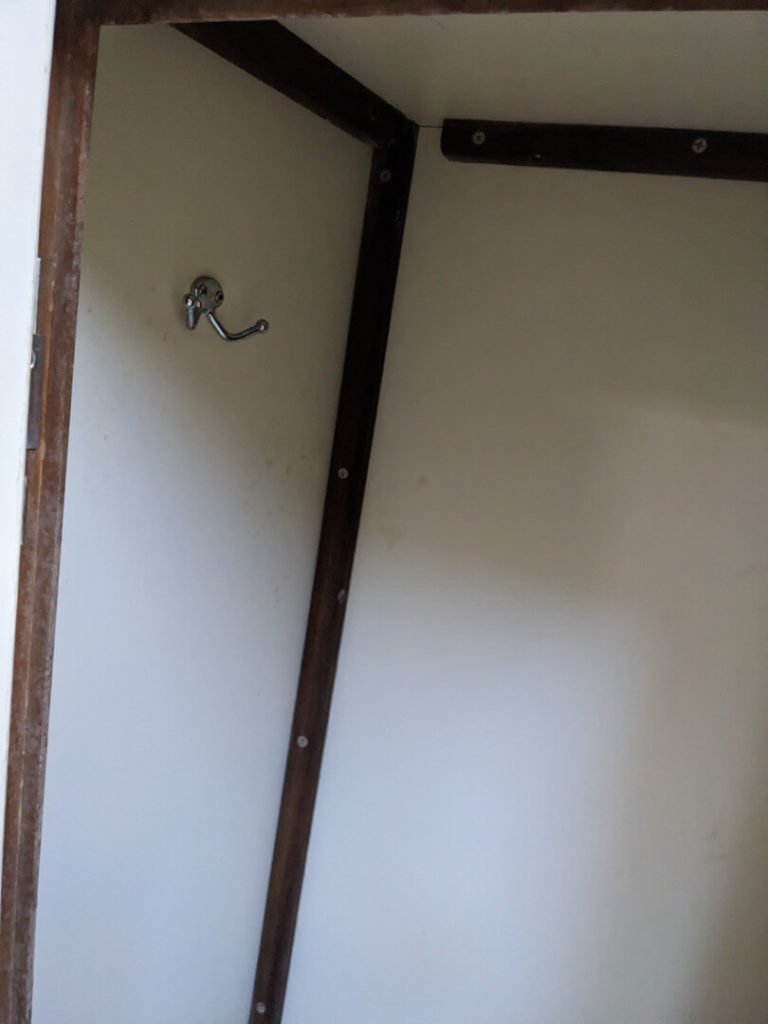
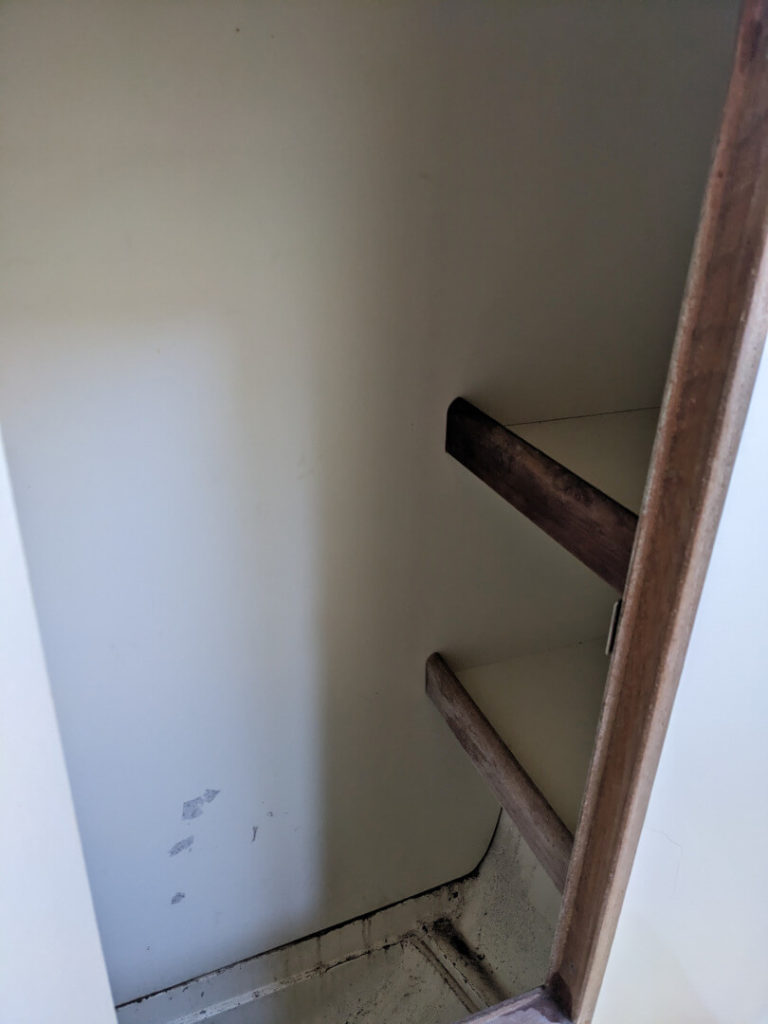
Shortcuts taken to make the Hunter 36 a value boat are most evident in the head. The wood, glass, and plumbing fixtures would all feel less out of place in a circa 1985 single wide trailer. Meanwhile, the Liquid Nails holding the mirror above the sink completely failed at some point prior to our rental.
The clip that hold the main head door open had lost all of its spring, leaving the open door swinging about. Meanwhile the shower door was equipped with a post and positive latch to hold it open…much more effective.
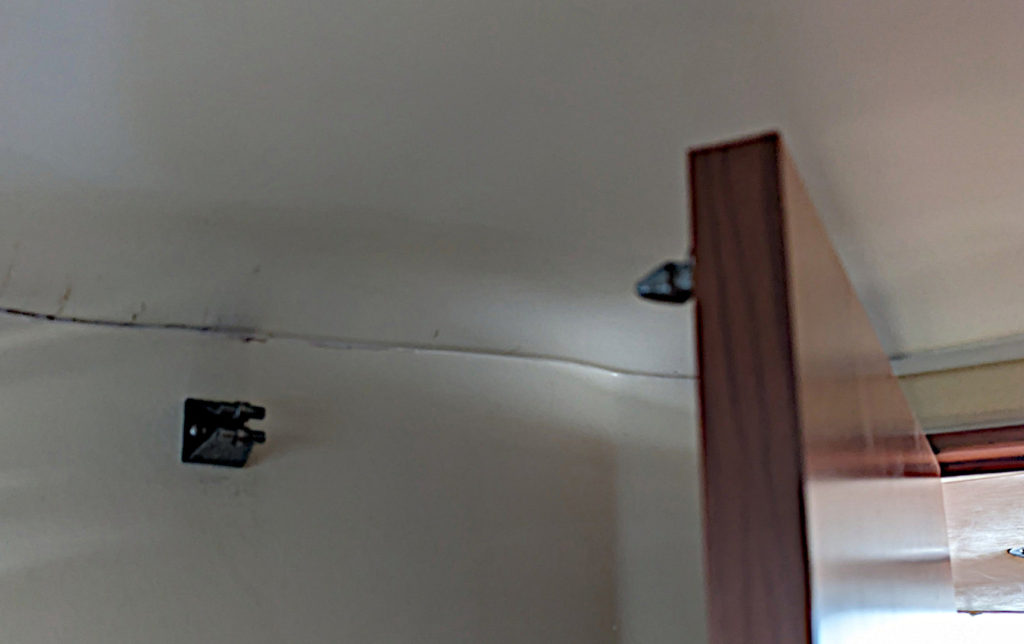
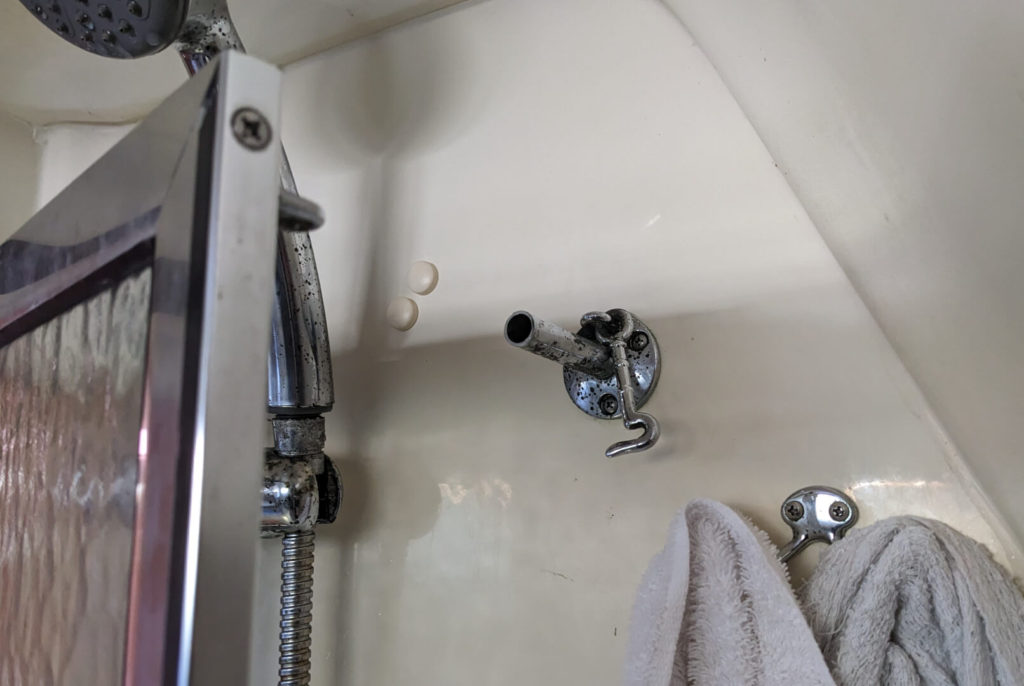
Systems onboard the Hunter 36
Engine

Our test boat was equipped with the standard 3-cylinder, naturally aspirated (no turbo), freshwater cooled 29hp Yanmar 3YM30 with 60 amp alternator. This boat uses a direct drive to spin the right handed prop. The engine is rated to run at a very brisk for 3,490 RPMs continuously, or 3,600 RPMs max. The engine likes to run hot, with Yanmar specifying a minimum cruise above 2,500 RPMs. Our tachometer was broken, so we just ran it up to full throttle and then backed it off a bit. Whatever speed this was, the engine sounded calm, cool and collected.
You know, every diesel that we’ve reviewed on this site so far has been a Yanmar. Heck, even the 37′ Merritt hosting our Maui Fishing Charter was repowered with Yanmars. They’ve ranged from 3 to 8 cylinders and under 30 to over 300 horsepower and spanning four decades of production. They’ve all been smooth, quite, compliant and caused us no issues. Despite most of them specifying a very high RPM cruise,, I’ve seen at least 8,000 hours on a meter, still running strong. I can’t say they are the best engine choice (don’t know that they aren’t either), but I can say that I adore them. I can also say they are a lot easier on your ears and dental work than the little Westerbekes from the ’70s and 80’s.
Inspection/Access
The companionway steps lift to access most of the engine components. We had a strut that was broken from its mount, so pre and post trip inspections were a two pollock job: one to hold the steps up and one to do the checks. There were also removeable panels on the sides and rear to allow access to the transmission and rear of the engine.
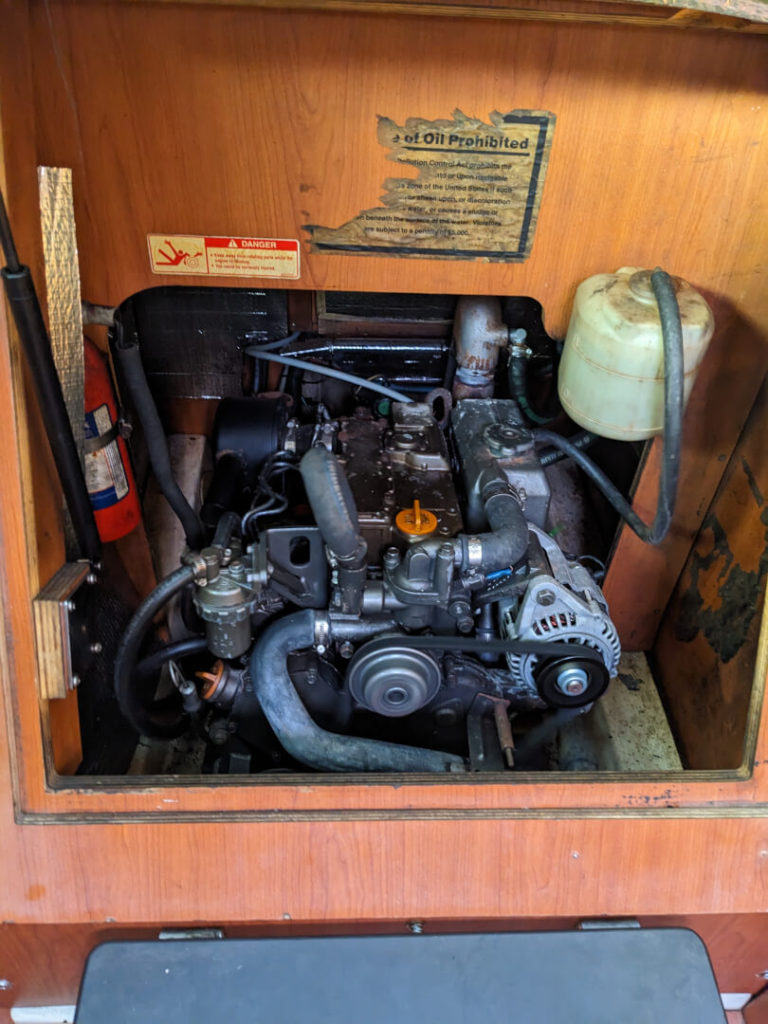
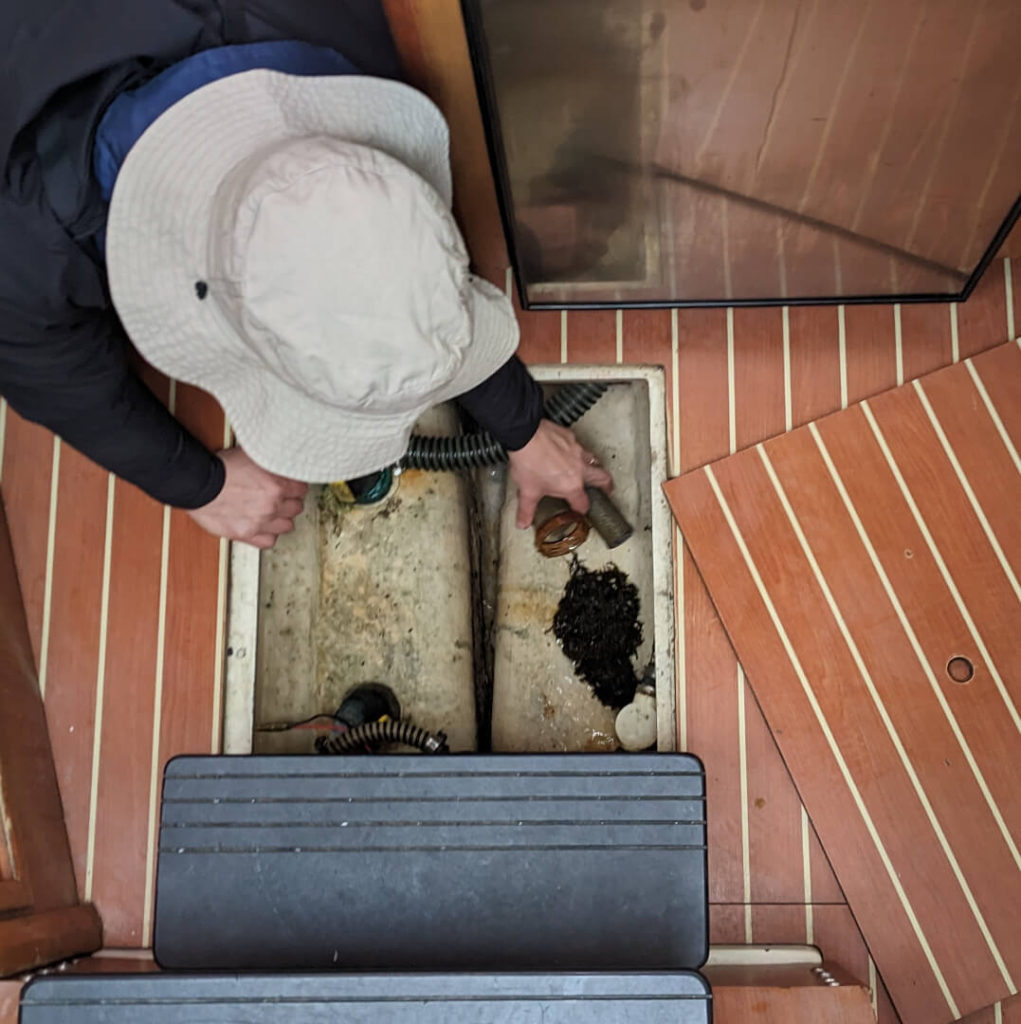
The sea strainer is small and below the water line. So you must check it often and you must close the seacock before opening it. Ours sucked up enough seaweed in a few hours of cruising to make a salad.
The starboard side and rear of the engine (as well as the transmission) are accessible through hatches in the rear stateroom. You’ll be thankful for this access if the shutoff solenoid on the engine control panel fails because you’ll need to close the fuel valve located toward the rear of the engine.
How Fast is the Hunter 36
With the throttle just a bit off full, which I’m guessing was around the manufacture remonded cruise of 3,400 RPMs, put us through the water at about 6knots. As you see so often in my rental experience, this is all estimated because both our tachometer and or water speed transducer were not working.
With a 31.5 foot waterline, the Hunter 36 has a theoretical hull speed of 7.6 knots. Our ~6 knot cruise suggests that the engine is adequate, knowing that it takes a lot of power to squeeze out that final knot of hull speed.
Hunter 36 Fuel Consumption
Once again, we were constrained in our test measurements. Perfect Partner was unable to successfully get us back to the dock in Long Beach to refuel and confirm our actual fuel consumption. So we’re left to make some educated guesses.
Assuming we were running 3,400 RPMs, the engine makes about 23 horsepower and burns 1.75gph. Running at 6 knots, we made about 3.5 nautical miles per gallon. That’s pretty abysmal for a boat this size. Would a larger engine turning at a lower speed have made a difference? Yes and no. If we’d had the 56hp motor from our Jeanneau 43 DS test, we would have needed to run close to 2,900 RPMs to get the same 23 horsepower. That is a lower engine speed and would have reduced our fuel consumption to just under 1.5 gph. However, on our test of the Jeanneau, we cruised at…wait for it…2,900 RPMs! The difference being that engine speed and fuel consumption bought us an extra knot of speed on a bigger, heavier boat. So what’s going on here? The remaining variables that come to mind for me are hull efficiency and prop sizing. Since the Hunter 36 sailed in the slightest of breeze, I’m left to wonder if we were simply under propped.
One way or another, if you want big range or low fuel consumption when renting Perfect Partner, you’ll either need to go very slow, or put up the sails. Her 38 gallon tank will only carry you about 150 nautical miles at our pace. All that said, fuel was included in our rental and even if we’d gotten to make a round trip to Catalina Island, we had enough fuel on board to motor the whole way.
How Loud is the Hunter 36 Engine?
Even over 3,000 RPMs, the 3-cylinder Yanmar was very smooth and quiet in the cockpit and cabin. Heck, even at full throttle, it ran smooth as silk. While the sound deadening didn’t appear all that robust, taking off a small side panel from the engine room created an exponenetial increase in cabin noise. Tight hatches and glued (vs screwed) hardware really served to quiet this thing down.
Hunter 36 Electrical Systems
The Hunter 36 is equipped with 12-volt and 120-volt systems. The 120-volt system operates from shore power or an optional generator (which our boat didn’t have). The 12 volt system is equipped with two group 4D batteries on a 1/2/both switch. So the engine and house draw on the same system, depending on how the battery switch is set. This is a simple system that gives you flexibility, but is prone to human error: leave both switches on with the engine off and you are gambling your starting reserves to run the house systems.
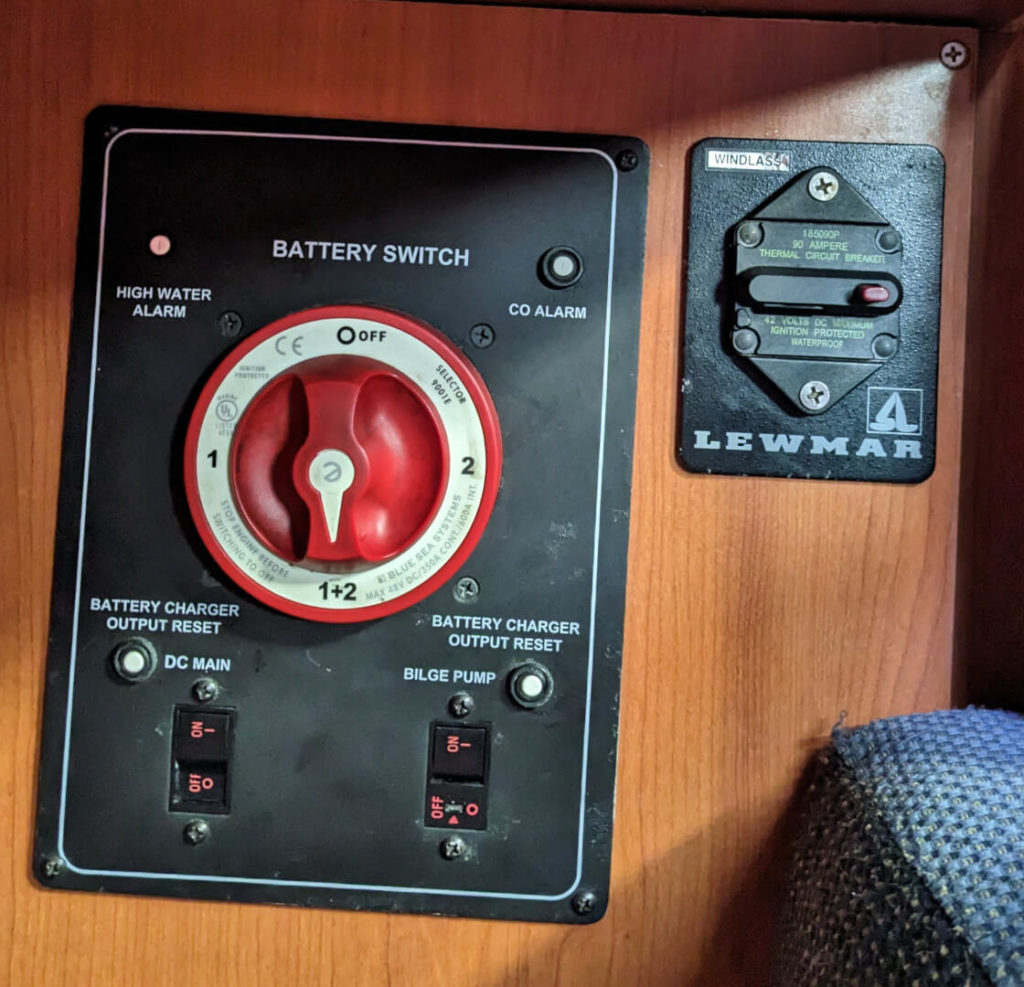
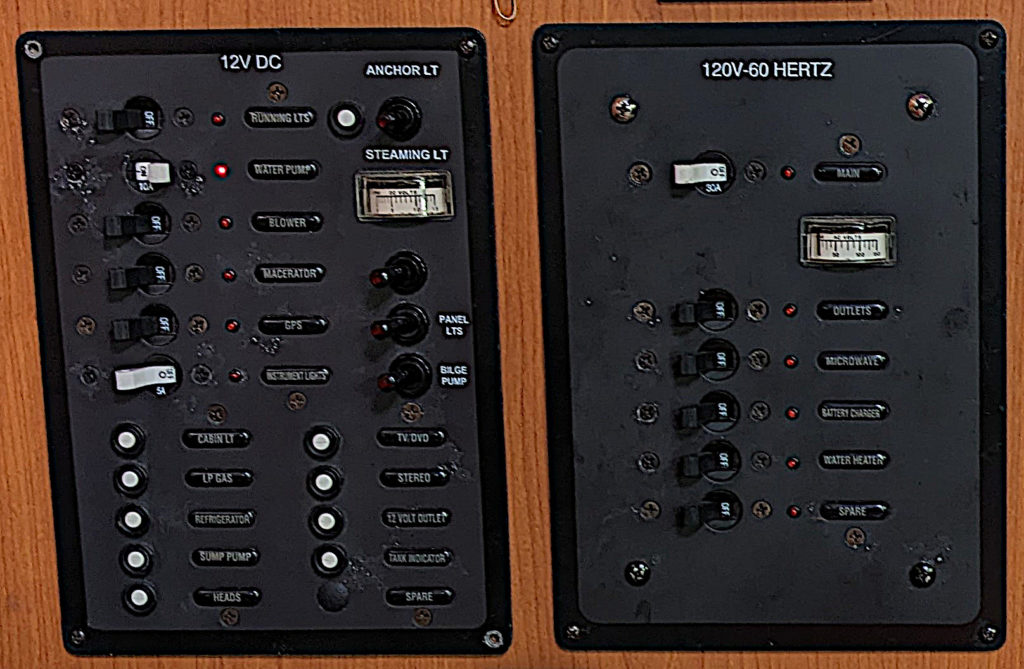
12 and 120 volt outlets are mounted thoughtfully throughout the boat with a set in each stateroom, between the galley and dining table, and on the nav table. Perfect Partner was equipped with one dual USB adapter as well as a USB port on the stereo. With the one I keep in my laptop bag, we were able to keep all the electronics topped up until our batteries failed.
What Went Wrong With Our Electrical System
Okay, here’s were I’ll note the worst problem that we had on this trip, and the first time I’ve ever had to call for a tow. On the third morning of our trip, about half way though our 12 mile journey.
When we initially inspected the boat at the dock, I noticed that the panel voltmeter was only reading about 12.5 with the engine on. Since alternators normally deliver more than 13 volts to the battery, I called this out to our dockhand. He said this voltage was normal for this engine. I accepted this because the low reading could have been from voltage drop between the battery and the panel or a poorly calibrated voltmeter. To give us our best chance of a good trip, I asked for a power cord to charge the battery on the dock overnight and slept easily.
Long story short, the alternator was not, in fact, working. The morning of day three, we had enough battery to start the engine and get under way. Running the electronics finished off the batteries while we were at sea. I cut the engine to check the sea strainer and couldn’t get it started again. With no wind and no way to control the boat in the mooring field at Avalon Harbor, we cad to call for a tow.

If any credit for this mishap should be directed toward the boat itself, I’d point to the voltmeter. It has a few deficiencies:
- You can only measure voltage on the battery(ies) that are switched on, as opposed to a separate switch for the voltmeter itself.
- The distance between 12.0 and 12.5 volts is like 1/32″, making it very hard to assess state of charge charge. In response to this experience, I bought a new 12-volt USB adapter with a digital volt meter.
While Hunter deserves some blame for a less than ideal charging and voltmeter design, the blame lies almost entirely with the charter company (and me for not being more thorough in assessing the situation at the dock, and not diagnosing the problem before both batteries were toast.)
Lighting
The Hunter 36 has lots of natural light a generous amount of overhead and side hatches. Electric lights were a mix of halogen and LED. We found them to be ample and well placed to give us enough light where it was needed without wasting electricity.
Ventilation
Perfect Partner had a dorade just forward of the companionway. This is the first boat I’ve ever sailed with a dorade. I have nothing to say about it. The boat did not have any fans, which would be a welcome addition for summertime cruising.
The numerous hatches mentioned above mostly open, but none of the overhead hatches have shades. This could be a real liability in hotter climates. On Perfect Partner, all of the overhead hatches were shattered. Whether this was a safety concern, or purely aesthetic, I cannot say. The side hatches, which were not broken, were very flimsy with the jankiest foam seats (calling them ‘seals’ would be an overstatement). The one in the aft stateroom was in fact pulling away from the frame and couldn’t be reattached without glue.

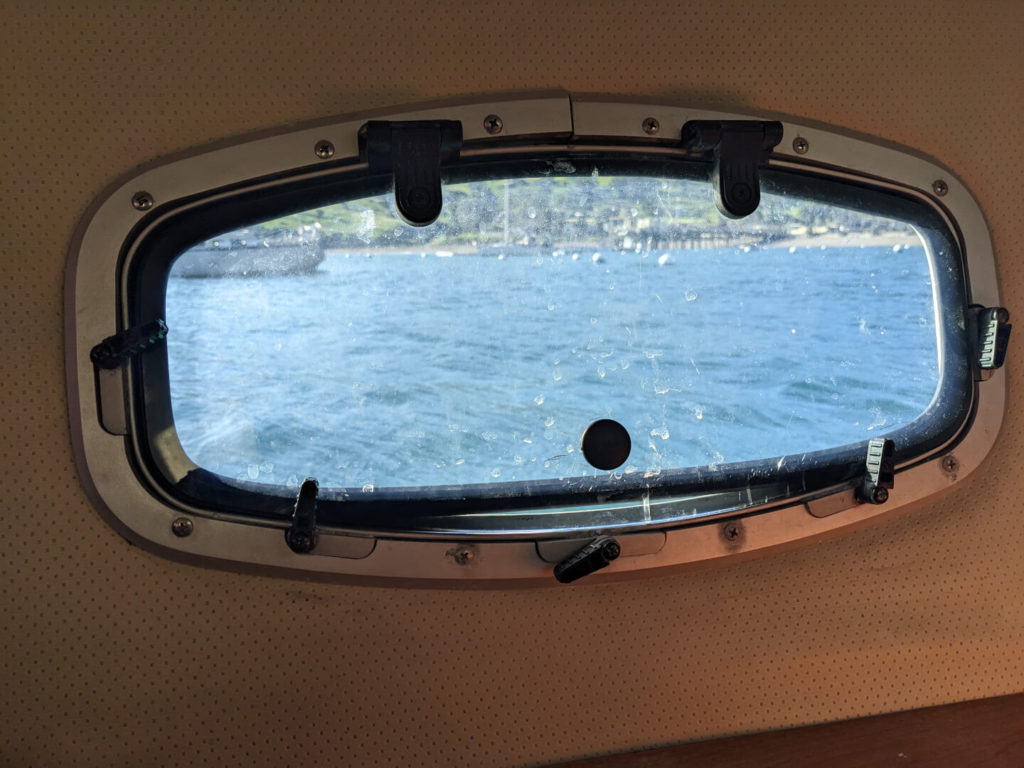
While the Hunter 36 can be ordered with generator air conditioning or diesel heat, ours was not equipped with either. For the mild cruising grounds of Southern California that Perfect Partner plies, they really aren’t necessary.
Water
Our boat was equipped with an optional hot water heater that works on the engine exhaust or 120 volt electric. We couldn’t get any hot water out of ours on the engine. Lemme tell you, waking up on a cool March morning under a paper thin blanket, there’s nothing better than a hot shower…and nothing worse than ice cold water running down your back.
We also had a very generous 75 gallon freshwater tan that we barely put a dent in without access to hot water. I was pleasantly surprised that this ‘budget’ boat was equipped with a tank indicator that could read both the fresh water and black water tanks. I think this is the only boat we’ve reviewed so far that had anything other than a ‘full’ light to monitor black water; and only the Leopard 43 had meters on the fresh water side.
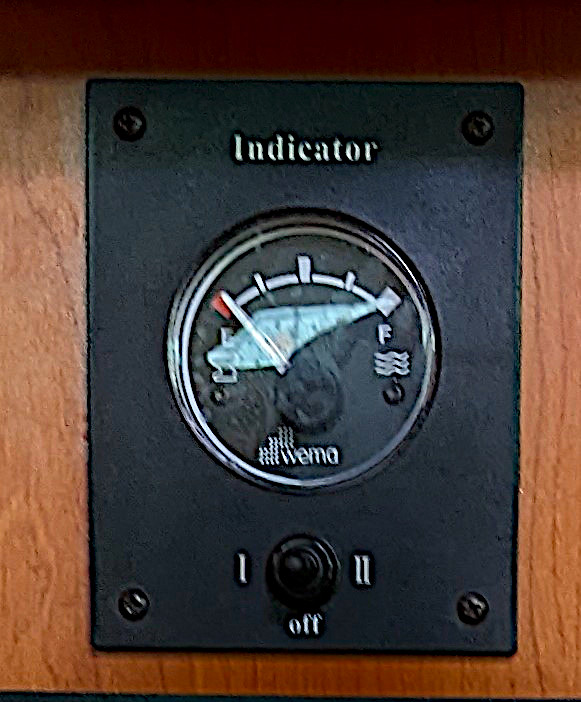
Head
Perfect Partner was equipped with a Jabsco manual head. It didn’t stink. Well…it didn’t stink until I deposited a chimichanga. An electric fresh water head is available as an option. Fresh water heads accelerate consumption from your freshwater tank, but tend to be less prone to making your boat smell like piss as the salt and microorganisms in seawater interact and do science with your #1 and #2.
Our boat was equipped with a macerator pump for evacuating the holding tanks at sea. There’s enough distance between Long Beach and Catalina that it is legal to do this (three miles from land). Its faster and less likely to get poo on your shirt/face than pumping out at a dock. Every other boat I’ve rented has a gravity drain to dump the holding tanks and they’ve never been a problem. Maybe a macerator is more polite than floating whole turds, but its an unnecessary complexity.
Note that in Catalina harbors you must have your holding tank valves closed. Nobody wants sewage collecting around the island. Sometimes the harbormaster will flush a dye tablet into your tank to prove your valves are closed. So make sure you know how to use them correctly before leaving the dock.
Anchor and Windlass
We didn’t get to use our anchor because we relied on mooring balls on our voyage to Catalina. However, the anchor was set on an electric windlass with foot controls at the bow. This is a bit less cumbersome than climbing on a berth to run a remote through the forward hatch like we did on our Jeanneau 43 DS.
CONSOLIDATE WITH BOW SECTION
Tanks
WHERE TO NOTE the Hunter 36 comes with a single electric bilge pump. There is a manual pump precariously located at the stern below the helm seat. Our pump handle was stored in the toolbox under the nav table.
The water tank had a very clever handle that flipped up to open, negating the need to keep track of those little steel keys…except the diesel tank did not have the same…and there were no deck keys on the boat…I asked for a deck key and the dockhand showed me the water tank cap, but not the diesel tank cap!!! Fortunately, the giant flat head screwdriver did the trick.
Bareboat Charter Equipment from Harbor Yacht Club
Dinghy
The dinghy is an optional upgrade at Harbor Yacht Club. We paid $25 per day for an 11′ rigid inflatable with a 3.5 horsepower Tohatsu engine. This was more than adequate…when we could get the motor running. The motor would either not start at all or stall when we closed the choke. We drained and replaced the fuel with a bit of success, then paid the outboard shop at Two Harbors to clean the carb. After that, it still took a few hail Marys to get her fired up, but we survived. One tip we got from someone on the dock was to close the choke, pull to start, and run the throttle up as soon as the engine starts to turn. I’ll remember that for future outboard headaches.
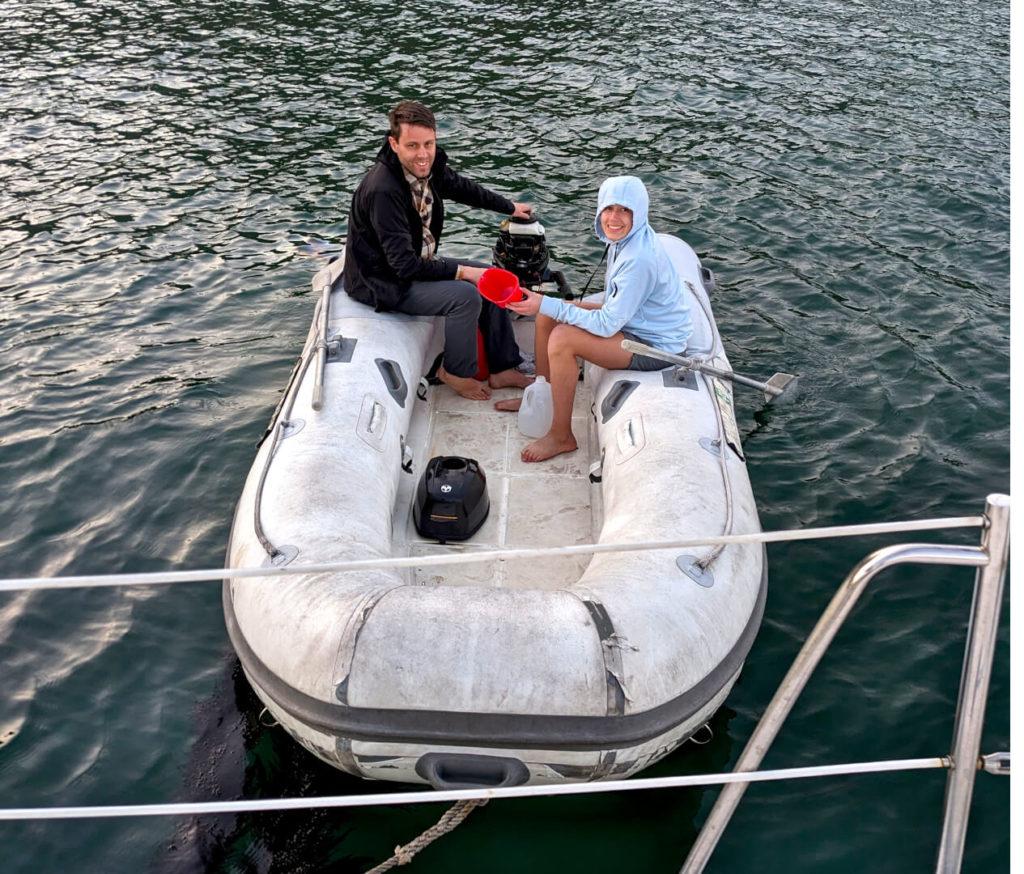
When we couldn’t get the engine running, we had one oar held together with duct tape and another held together with a paper clip. The duct tape was far more effective, with the paper clip oar bending with every stroke. This meant we had about 5 strokes to make on the paper clip side before pulling once on the duct tape side…it took us a while to get ashore with this method.
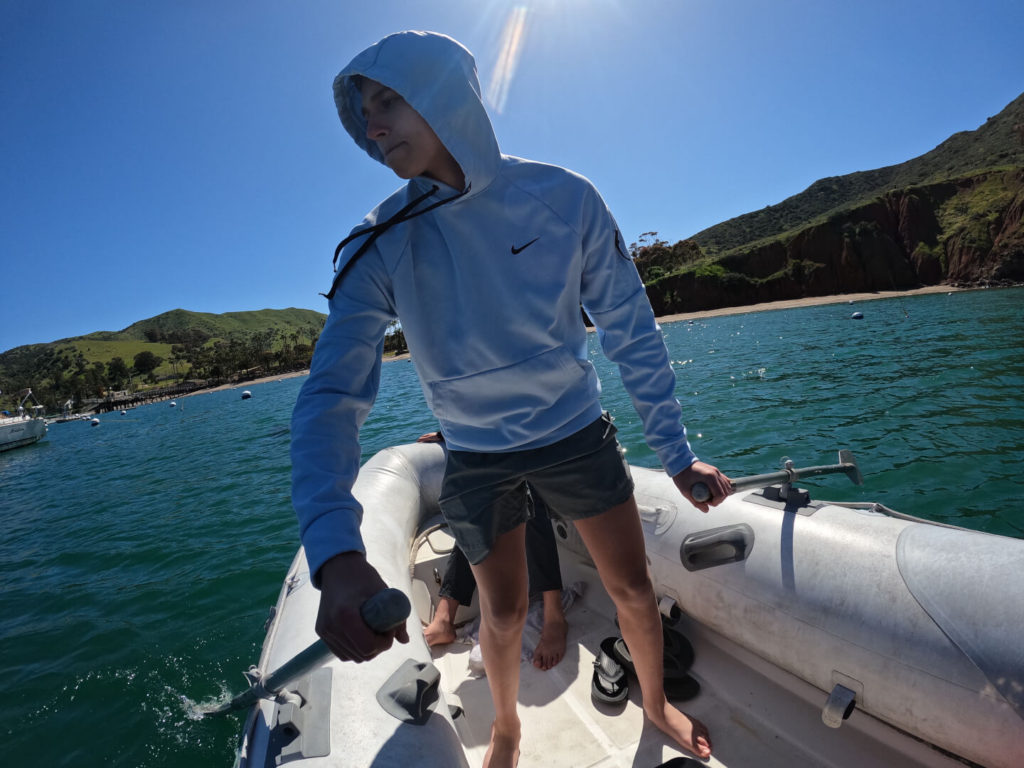
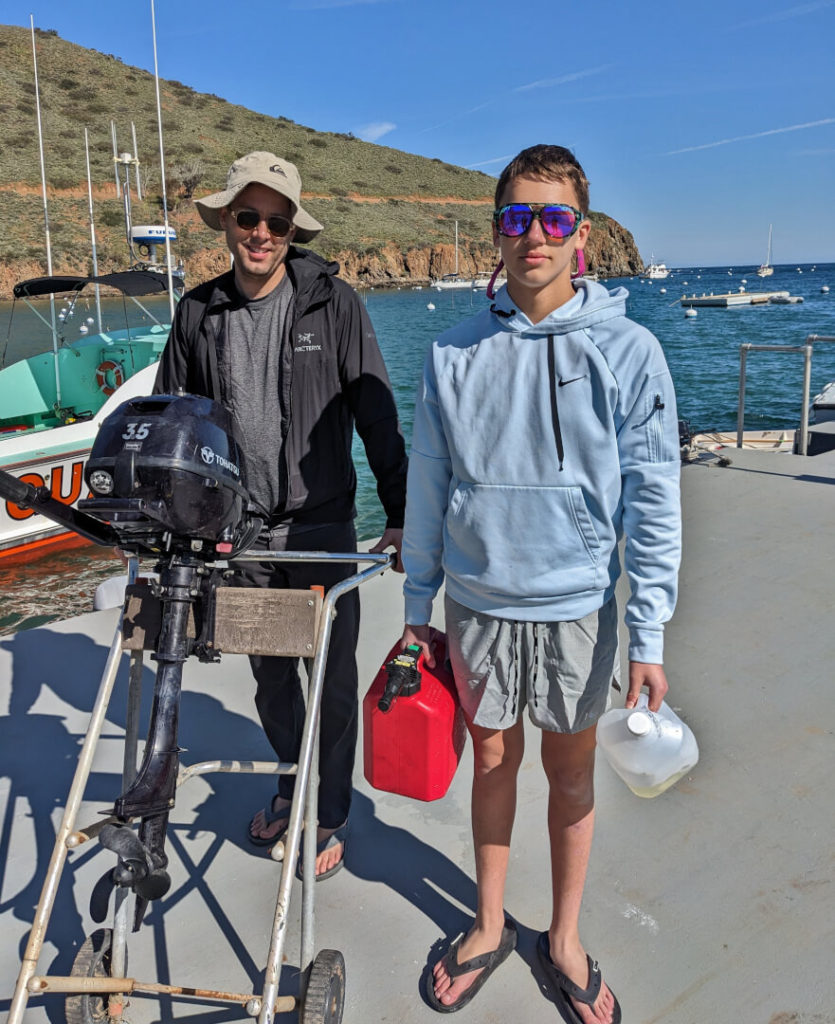
Barbecue
Harbor Yacht Club had propane barbecues available on the dock. We didn’t take one as we planned to eat most meals ashore on our trip.
Life Vests
Our boat was equipped with a pile of cheap offshore compliant orange life vests. I’d only wear one if my life depended on it. We brought our own inflatable jackets.
Tools and Spares
Our boat was equipped with the bare minimum. Giant phillips and flat screwdrivers, channel locks, and a spare impeller. The giant flathead screwdriver proved useful for jimmying the broken neutral switch on the throttle.

Linens
Linen packages are optional at Harbor Yacht Club at $25 per person. If you overnight, you will need them. They include sheets, blankets, towels, and wash cloths. The thin blankets were not adequate for the cold weather we experienced in March.
Between this and the thin foam mattresses, consider packing some small sleeping bags and sleeping pads or wool blankets if you end up rolling the dice with Harbor Yacht Club..
Features to Look for in a Hunter 36
The Hunter 36 is available as a very basic boat, with many options. Without seeing a price list, I’d assume this allows a great value for a day sailor in mild climates. Or a fully equipped boat for multi-day cruisers at an appropriate premium. As a renter, it means you may find a wide range of equipment (or lack thereof) on your boat.
Unless we’re in a very warm clime, we want hot water…and this trip proved how much we missed it. This is a very small boat to have a generator and air conditioning, but a very welcome feature if you are anywhere warm enough to not need the hot shower.
If you know how to use a spinnaker, you’ll definitely want that to overcome the limitations the B&R rig brings to downwind performance.
The standard bimini will offer some shade, but you’ll want a canvas package with dodger if you are expecting rain.
Hunter 36 Problems
For all the shit talking, our boat was, overall, a very well built boat. The fiberglass was in fantastic condition despite being neglected in a rental fleet for 15 years. Unlike the Lagoon 380 docked next to us in Long Beach, Perfect Partner was still bright white with no blistering or cracking. Most hardware and systems are from reputable manufacturers. Most of the sailing hardware and helm equipment is Lewmar. All but one top hatch was also Lewmar. I must assume the lone Bowmar hatch in the aft stateroom was a replacement. The opening side hatches were not branded and were total garbage.
The interior of the boat was held together almost entirely with Liquid Nails (glue). Compared to screws, this construction method makes it difficult to take anything apart, and by the time we got to the boat it had started to fail. The mirror was gone from the bathroom, with big plastic panel covered in glue lines remaining. Lots of little wood trim pieces were missing from the cabin. However, keeping a tube of Liquid Nails handy for repair would make keeping these things together pretty easy. What I hadn’t anticipated was how quiet this boat was with the glued hardware. Compared, again to the Jeanneau 43 held together with screws, there was much less to squeak or rattle when running the engine. All of the floor hatches fit very tight, which also reduced the rattling, but made it difficult to put them back in place once removed.
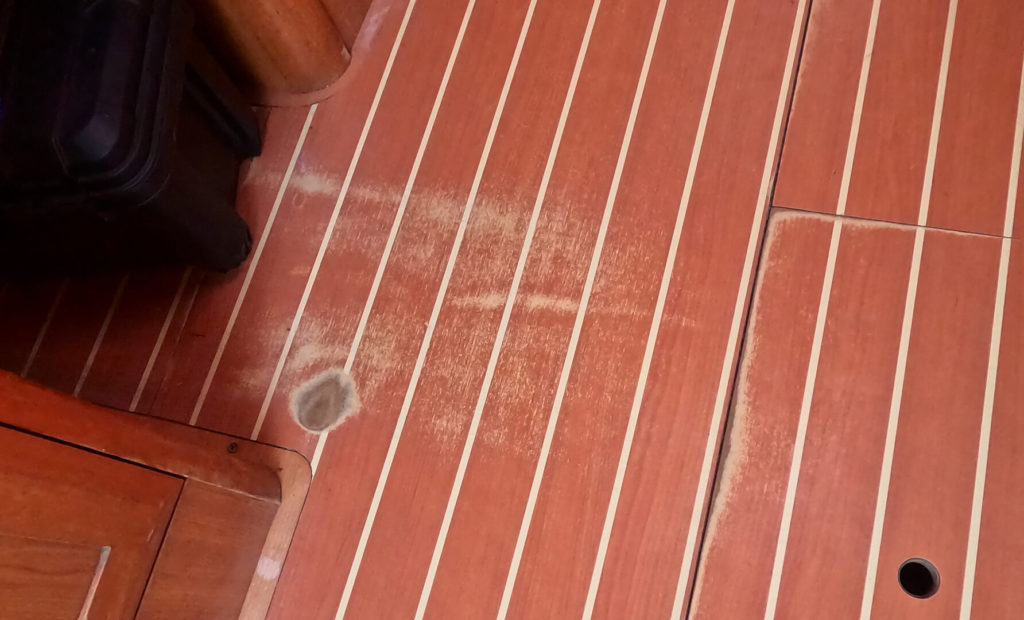
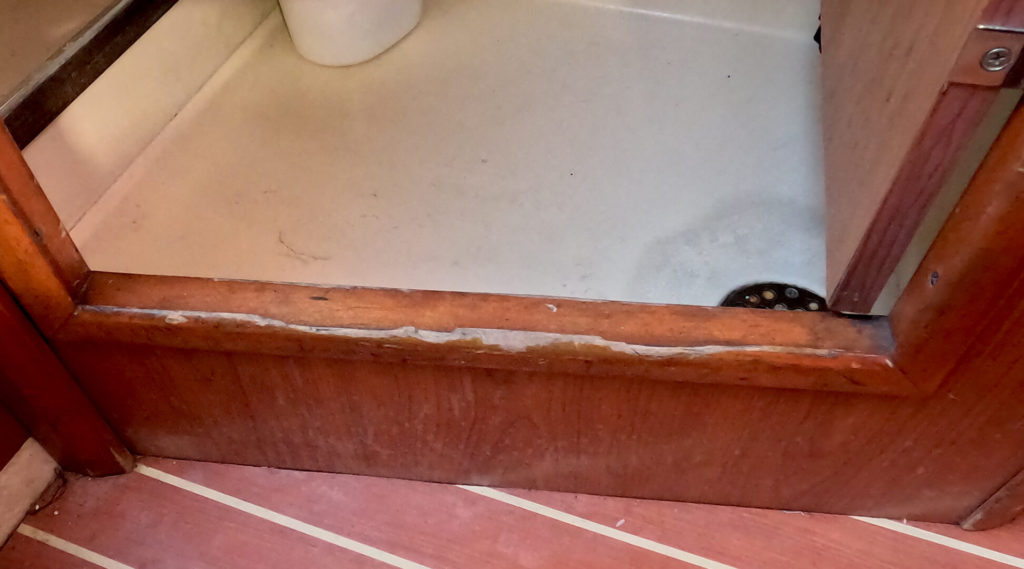
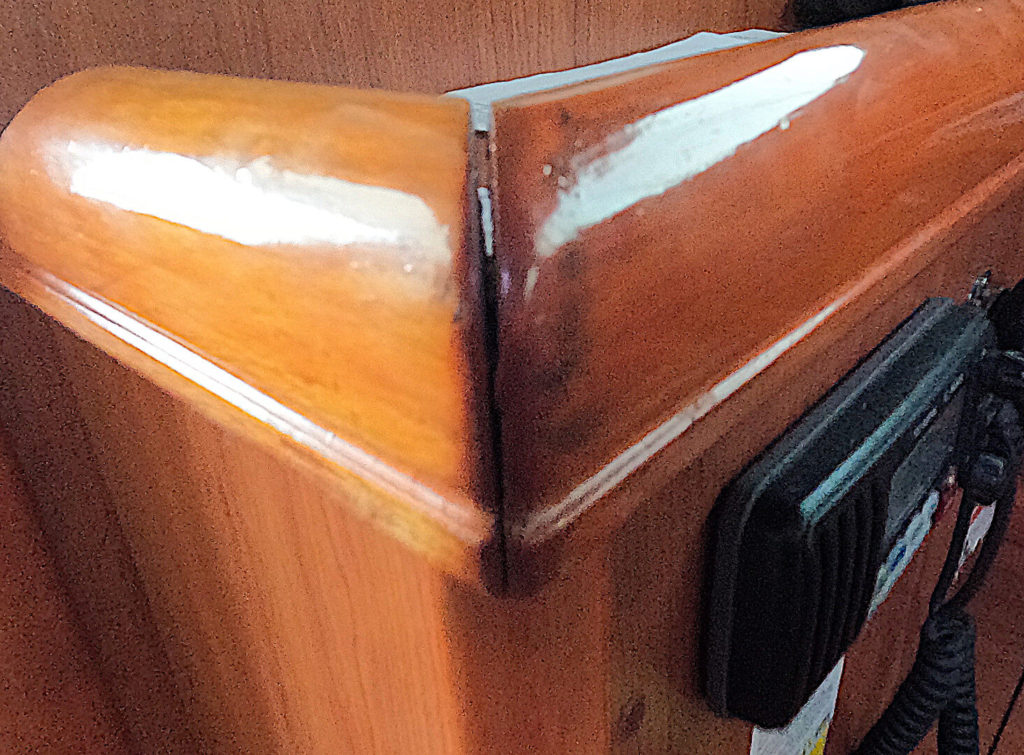
Most of the wood was laminate or veneer. While some of it looked cheap, for the most part, it aged and wore surprisingly well. We did have some wood veneer peeling back in the aft stateroom…again, would be easily repaired with some Liquid Nails.
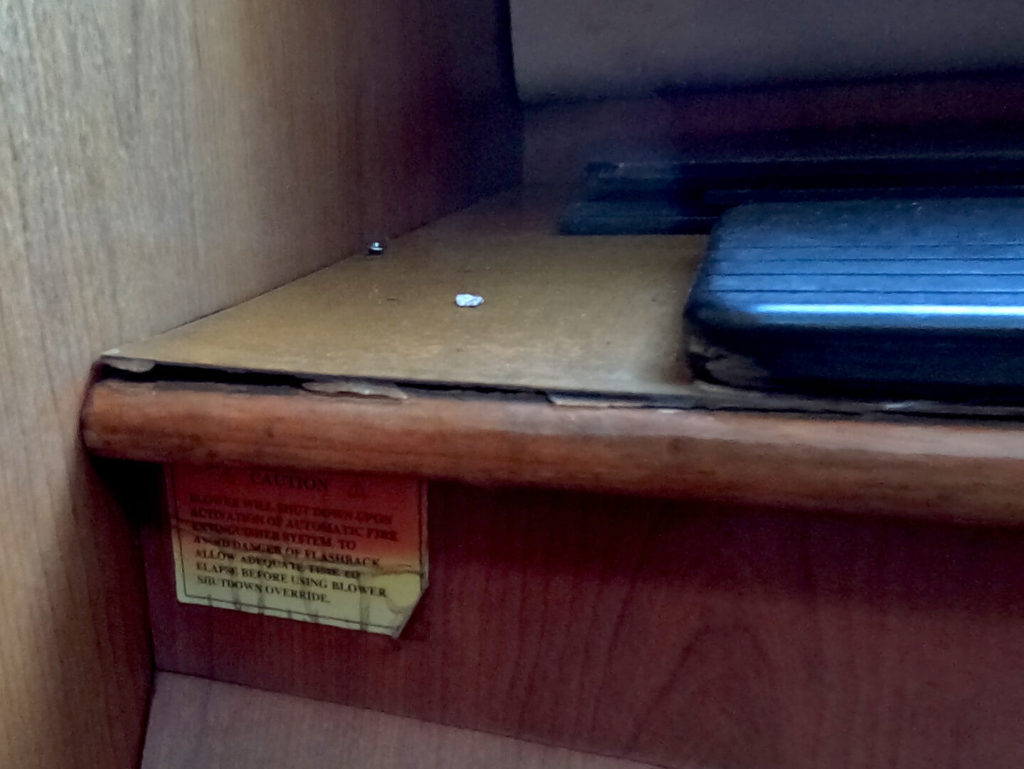
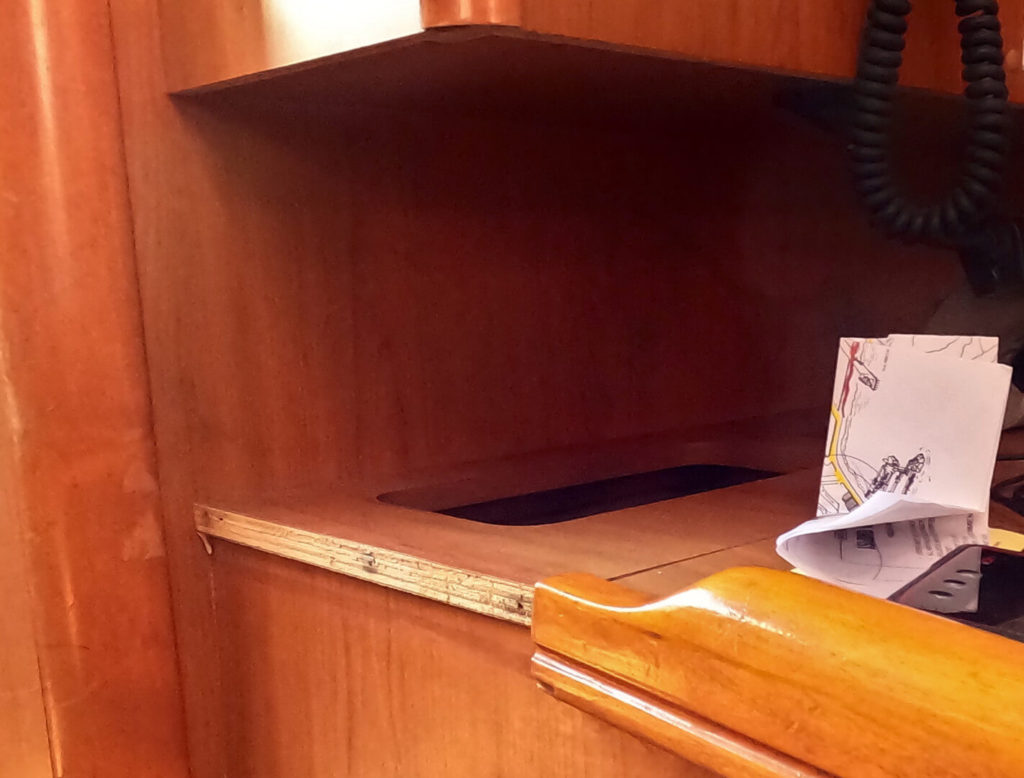

The side hatches were flimsy garbage (only at the stern)
There was a weak spot on the bottom step of the companionway that didn’t inspire confidence when decending into the salon. While this is probably a true weak point in the design, it would be easily shored up with a small bit of wood.
The gimbaling stove could not be locked into place because the lock was not in same position as hole. I’ll take a stab and guess that this is not the factory stove. We also had one burner that wouldn’t stay lit. At checkout, the dockhand said he’d just cleaned it and it may have had some water in it. It’s a Force 10, which is pretty much the only brand of marine stove I’ve ever seen.
We did have one a serious problem on this boat: a bad alternator coupled with some abused batteries. While they appeared new, the batteries didn’t hold much of a charge. So, we ran out of juice pretty quickly without the ability to charge while under way. Look for a more in depth post about this mis-adventure soon.
Alternatives to the Hunter 36
There’s a host of other monohulled coastal cruising sailboats in the mid to high 30-foot range that could pinch hit for the Hunter 36. In fact, this boat, referred to as the Hunter 36-2 is actually the fourth 36 footer from Hunter. The original Hunter 36 ‘Cherubini’, the Hunter 36 Legend, and Hunter 36 Vision preceeded it. More recently, the Hunter 36 has been redesigned and rebranded as the Marlow Hunter 36. Pit this boat against similarly sized coastal cruisers from Catalina, Jeanneau, and Beneteau.
How Much Experience Do You Need to Rent a Hunter 36
Harbor Yacht Club is willing to put you on the water with a sailing resume and no questions asked. Well, that’s not exactly fair. After calling the office several times to get the gate code, then asking a private boater where Habor Yacht Club is (its in a garden shed leaning off the dock) we found the dockhand that led us down the scraggly dock to Perfect Partner and asked one question: ‘do you have any questions about the boat?’
But seriously, the Hunter 36 is an easy boat. Its at the smaller end of what you’ll find in most bareboat charter fleets. This, combined with its compliant maneuverability make it easy to dock. Simple systems and furling sails mean are also great for beginners. If you’ve never worked with self-tailing winches and a furling main, this is a great boat to cut your teeth. You could definitely stay out of trouble for a few days after completing ASA 103 or even maybe pad your resume and teach yourself how to sail if you’ve got solid powerboat experience and a competent crew.
Where Can I Rent One and How Much Does it Cost
For a four-day rental from Harbor Yacht Club, we paid $2,650*:
- $2,132 four day charter fee
- $110 pre-board evening before
- $100 four day dinghy rental
- $75 three linen packs
- $42.68 four days of fuel
- $233 taxes and fees
Our journey cost quite a bit more than that because of our problems with the boat. We also spent $931 dealing with our breakdown, bringing our total to $3,585. The big nut was $650 for a tow because Harbor Yacht Club had apparently let its SeaTow membership expire a full year prior. We also spent $150 to get the outboard repaired, $125 to get home on the ferry as we had to leave the boat on the island to make our flight home, and $9 at the public showers in Avalon. After several weeks of the general manager at Harbor Yacht Clubs shirking my calls, I filed a dispute with our credit card company, Citi. We were able to recover $2,125 which covered all of our out-of-pocket costs and half the cost of the rental. After the refund, I’d give this rental 5 Busy Boater Stars for value…but I need to shave some stars off of what would have been five-stars for convenience and time efficiency.
If you’d rather roll the dice with a different charter company, a sister ship is available on Lake Superior for a similar price.
Conclusion
Perfect Partner is a great boat despite its age and questionable provenance. Standing up to the neglect and abuse of the past 15 years of charter service is a testament to Hunter durability. Not only is it durable, but Hunter packs a metric poop ton of boat into 36 feet both in terms of accommodations and performance. In addition to value, its size makes it manageable by a light or inexperienced crew. So we give the Hunter 36 the Busy Boater seal of approval.
Of course I’ve pointed out that the Hunter 36 delivers a mixed bag in terms of design and finish…strangely very good in some areas and not so good in others. But those are easily overlooked, especially as a renter. But if you are looking to show off the most luxurious interior or comfortably and safely cross an ocean, there are definitely better boats on offer for more money.
However, when it comes to Harbor Yacht Club, the convenience of renting from Long Beach was far outweighed by the inconvenience of a poorly maintained boat that literally left us in the cold [water] and stranded us at sea with an expired towing membership. I never expect perfection from any boat, let alone a rental, but be very wary of a rental company that pretends to have your back, then ghosts you the moment you disembark.
